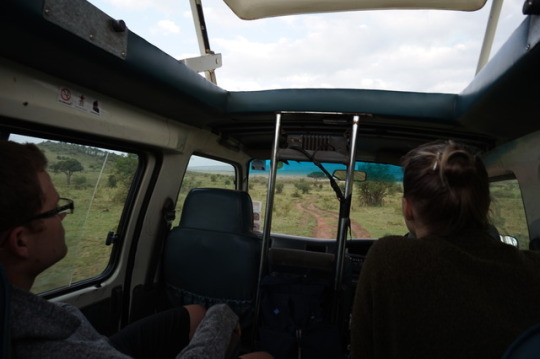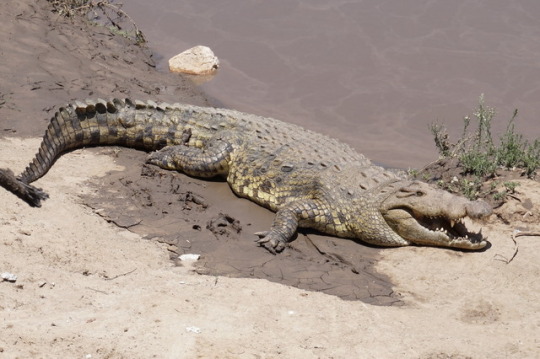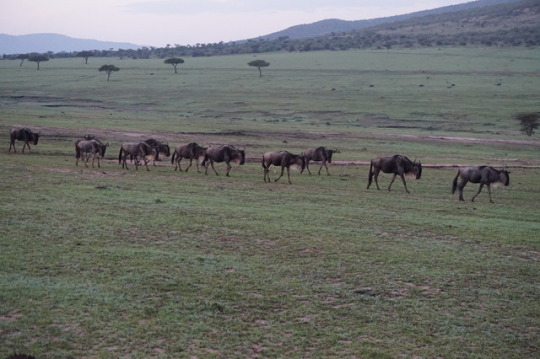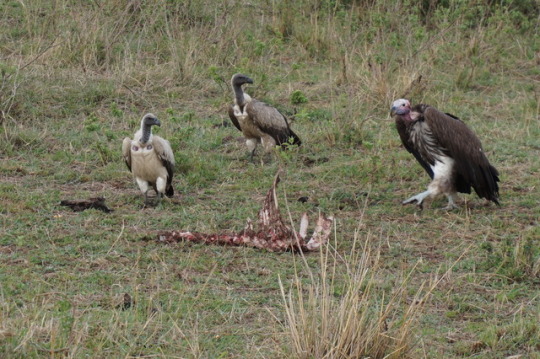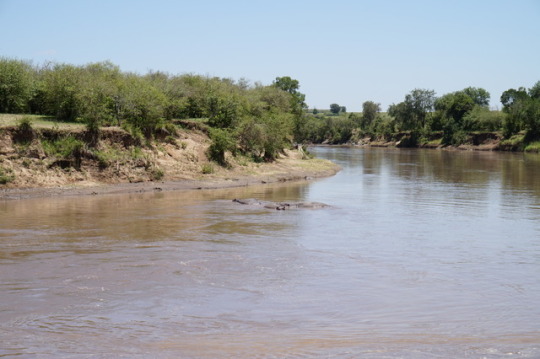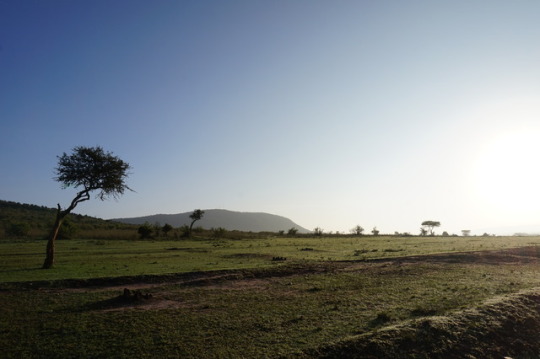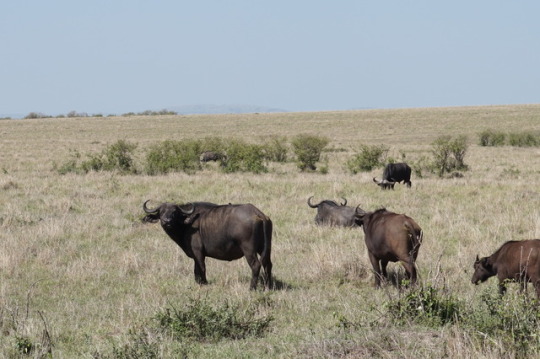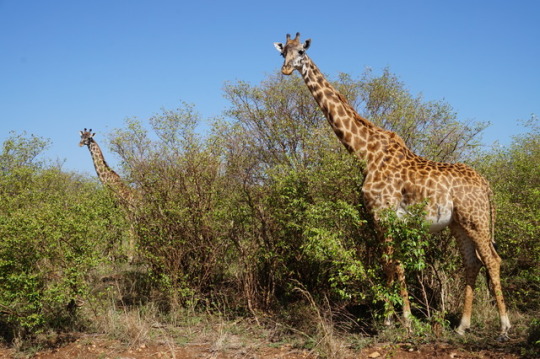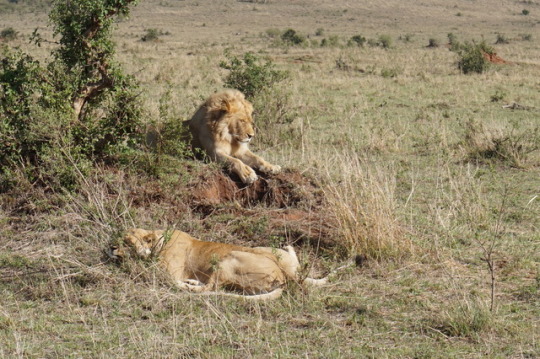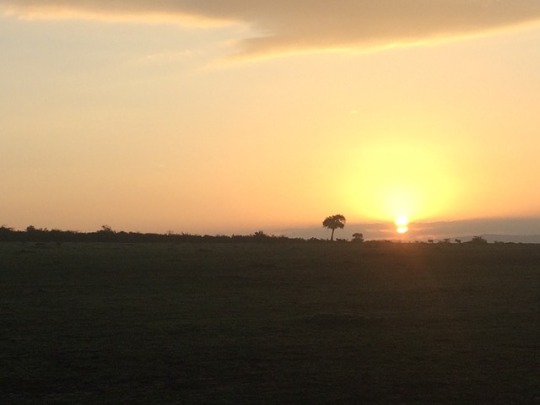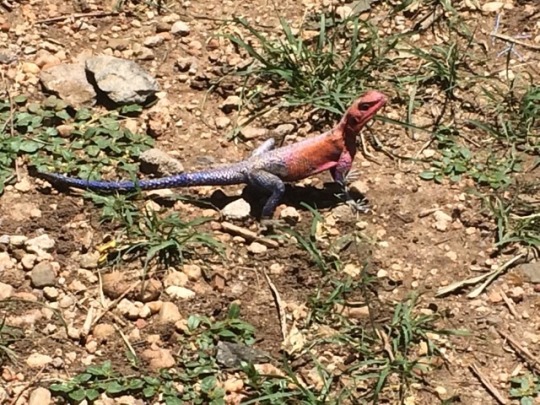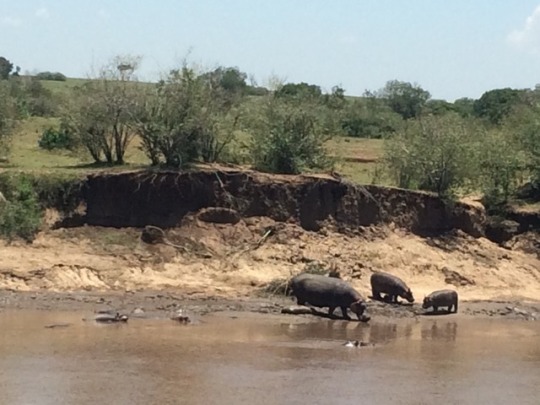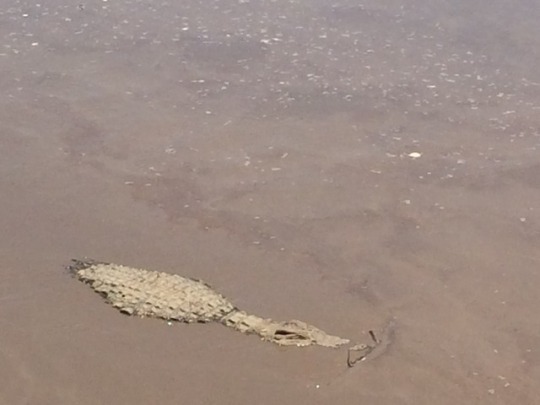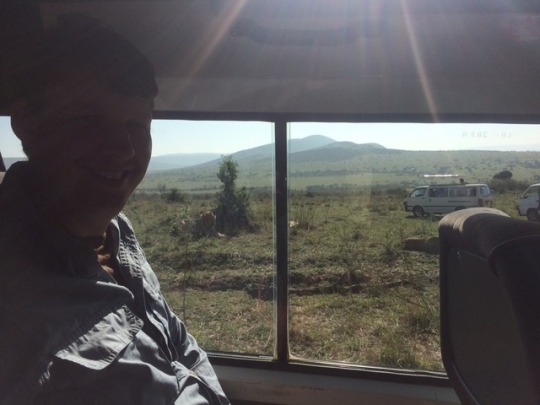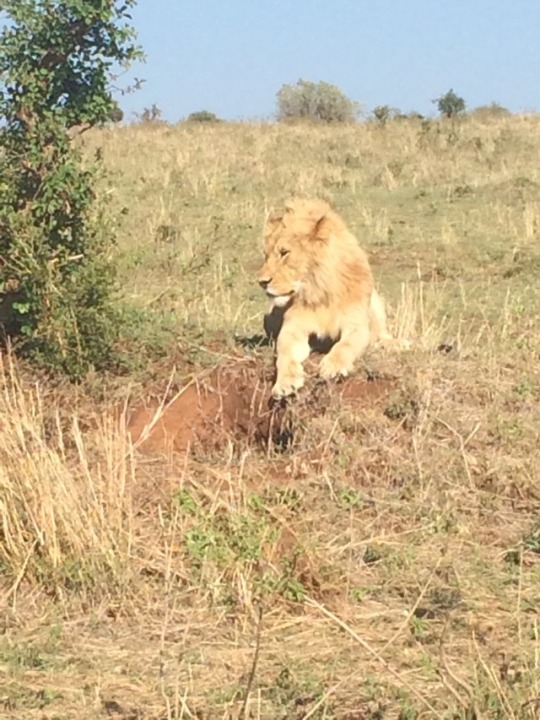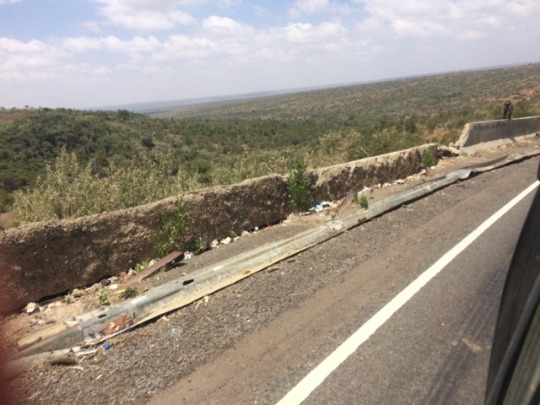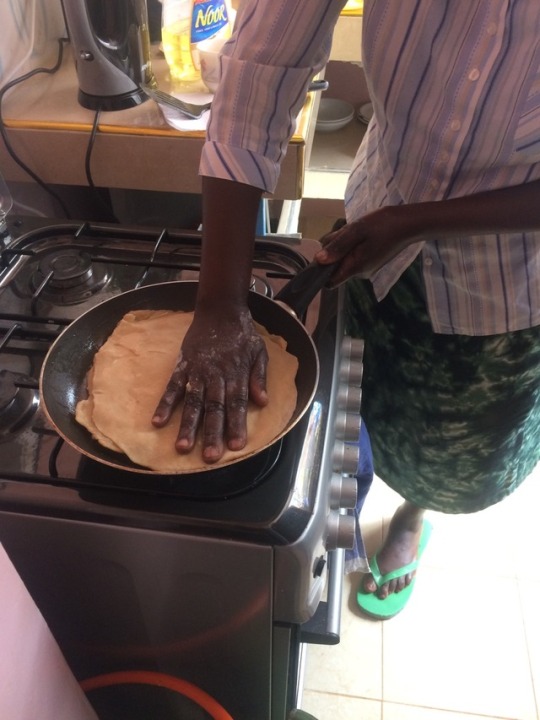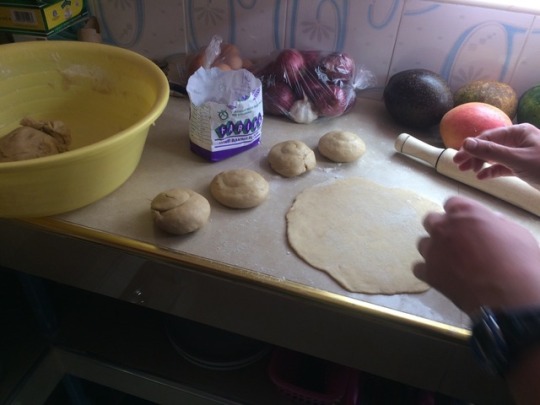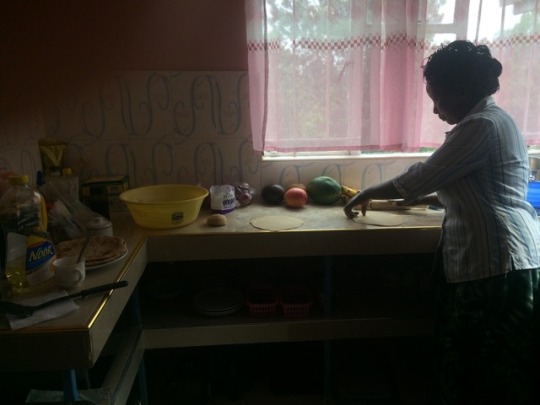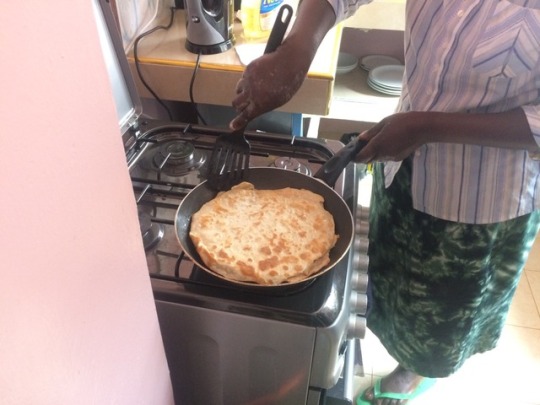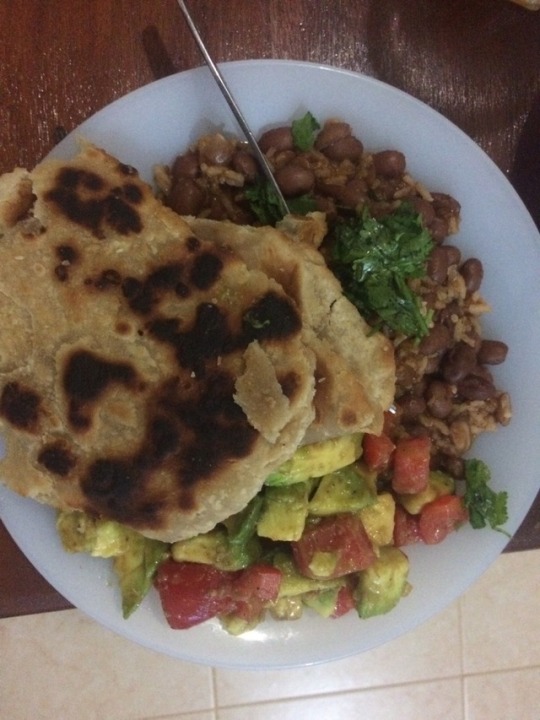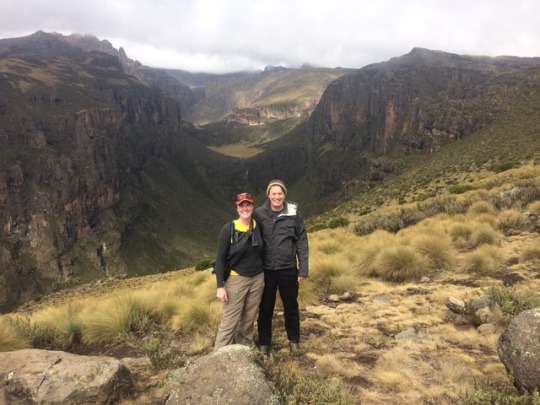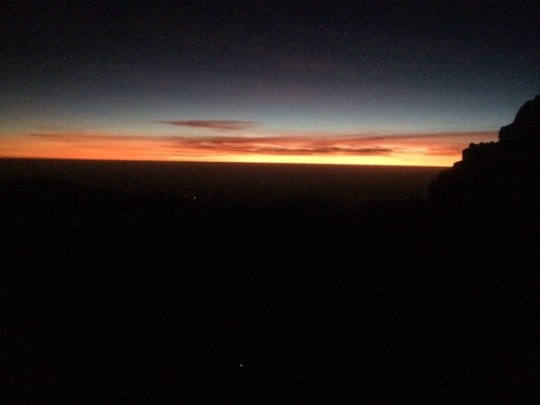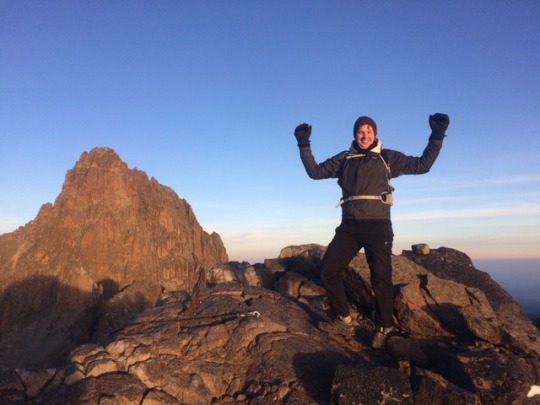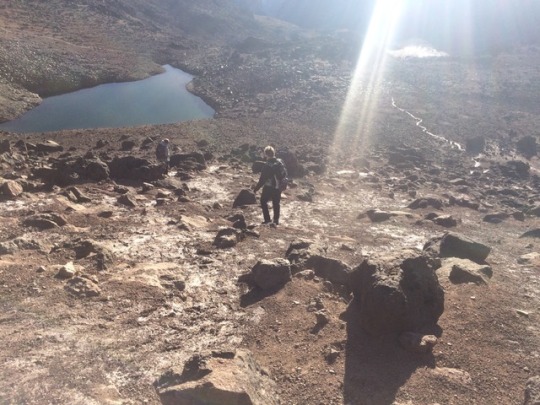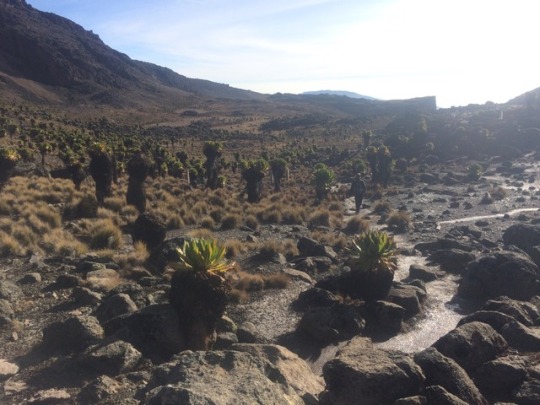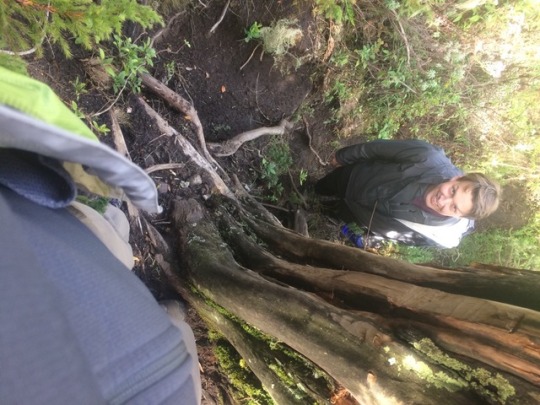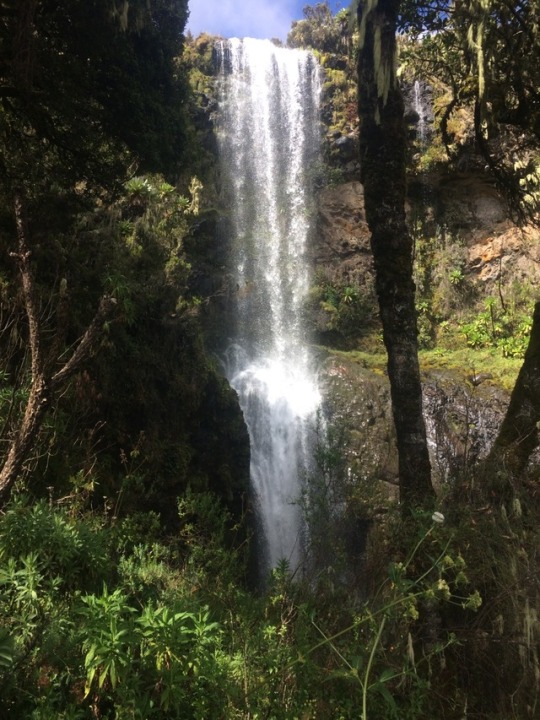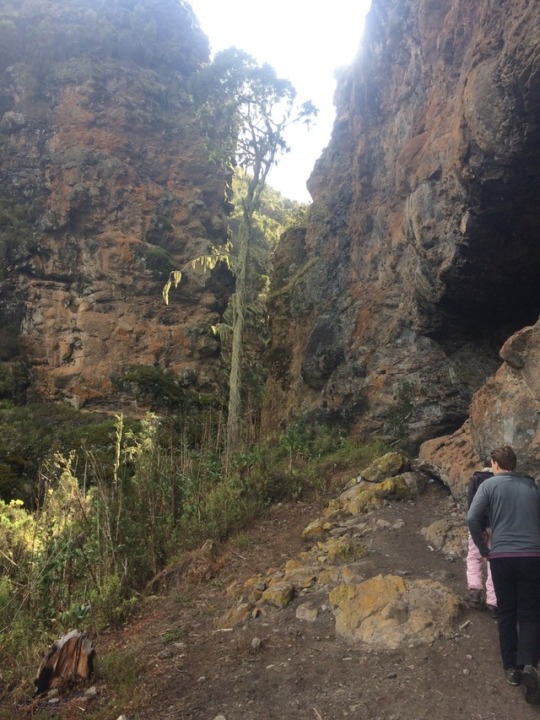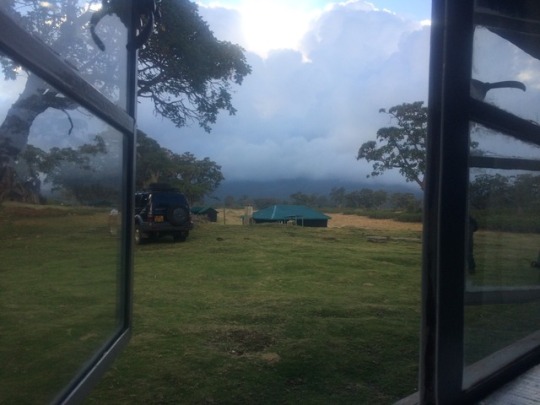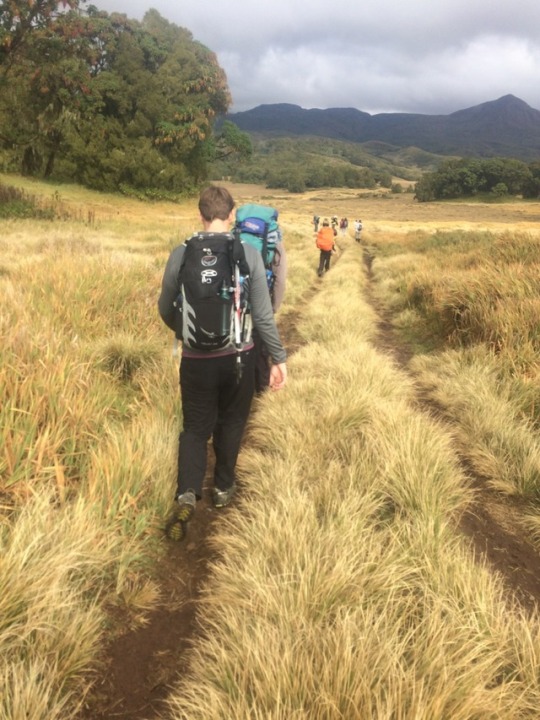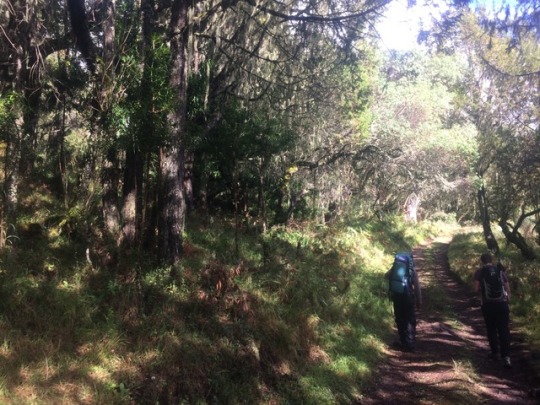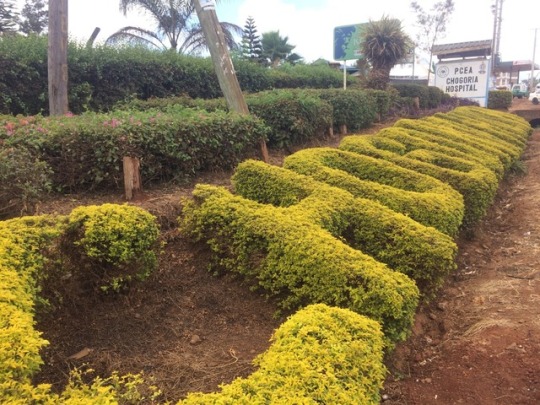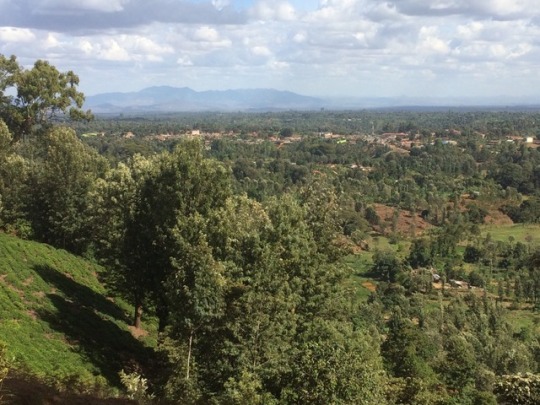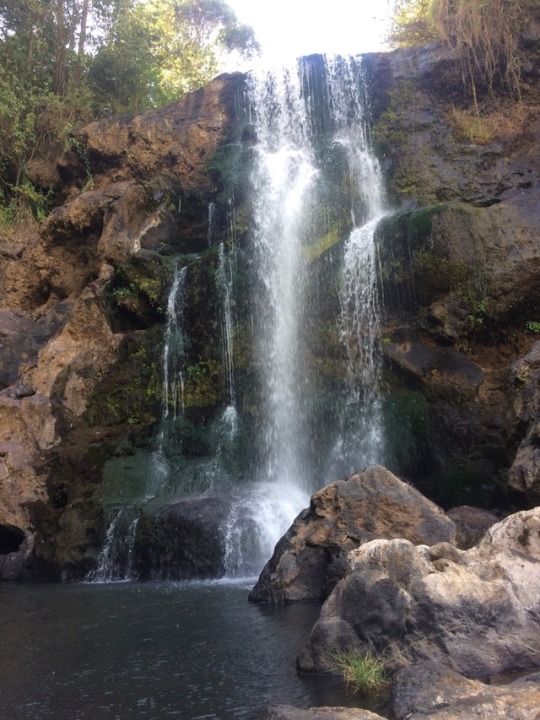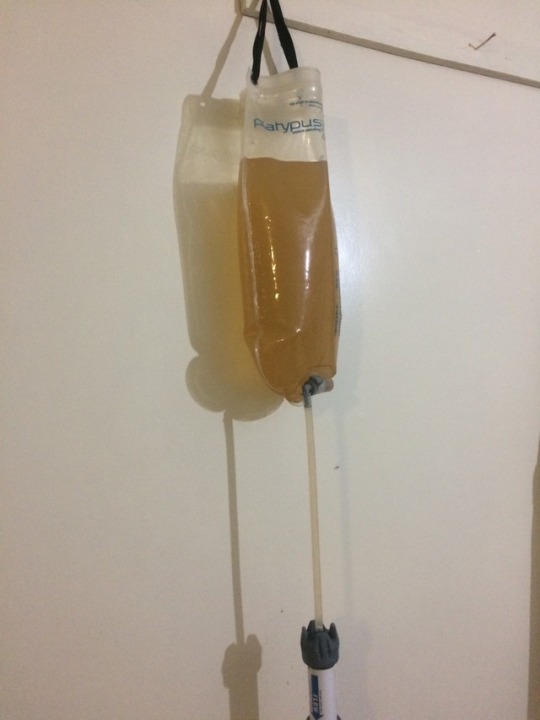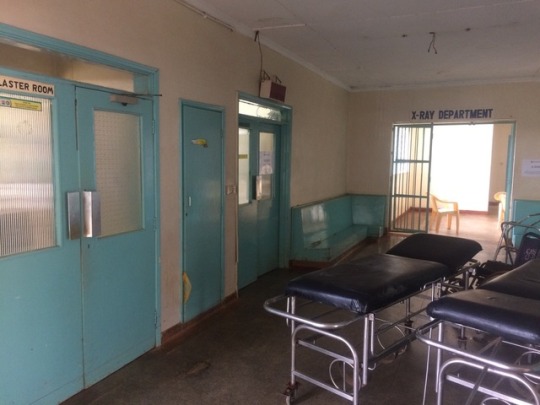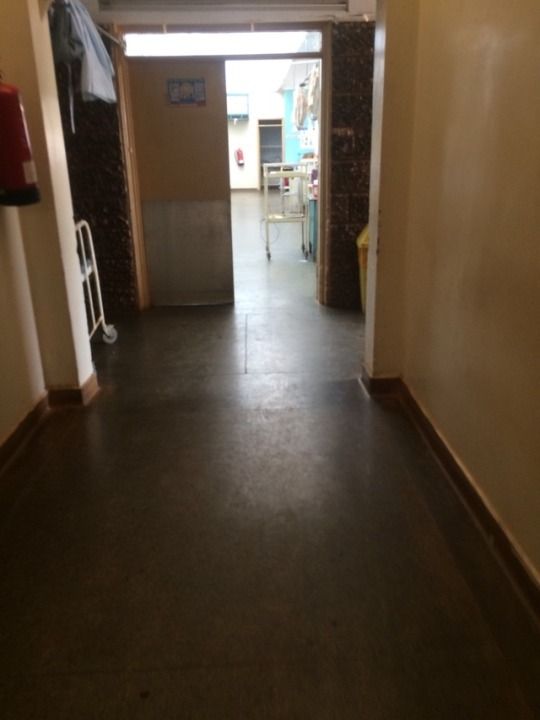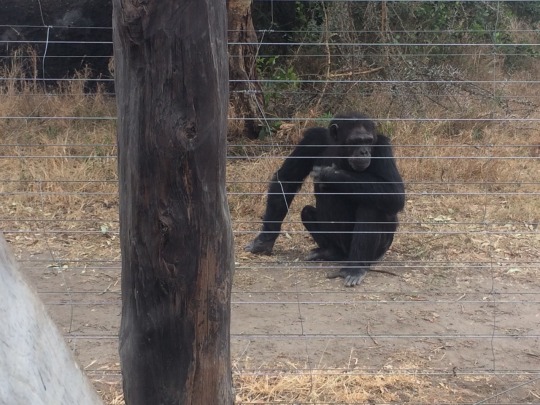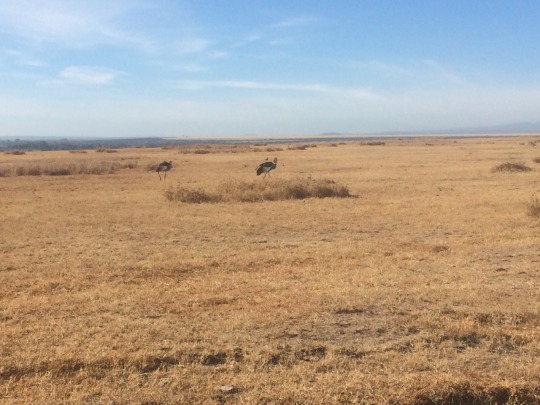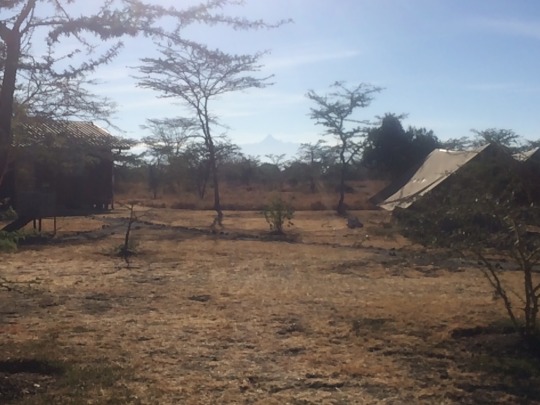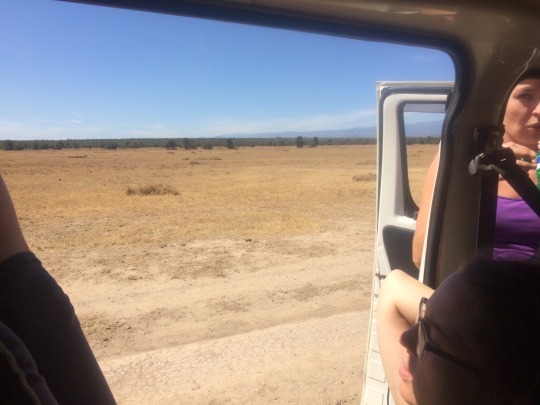A photo journal of our voyage to Chogoria, Kenya. This is an informal page of my thoughts and experiences. Please note that the most recent day is posted at the top -- in order to read this in order, begin at the end!
Don't wanna be here? Send us removal request.
Text
The Legendary Masai Mara
February 26, 2017
Thursday evening after ward rounding Luke and I packed and cleaned the apartment in preparation for departure the following morning. We over ate at dinner to finish our leftovers and other things that we didn’t want to throw away. Luke made a delicious cold pasta salad with pesto, beets, and green peas for us to eat on the road. I made some PB&J’s and chopped up some fruits. We were ready to go Friday morning after making a large breakfast and packing the last of our dried laundry and camelback/filters. Leonard and a PCEA driver met us at 9am and we loaded four large suitcases and our carry ons in to the car (they fit but juuuuuust barely)! I got the front seat while Luke, Leonard, and another person we were driving to Nairobi sat in the back seat. Luckily there were seat belts that worked as the drive gave me anxiety. I personally don’t see why speeding through town really benefits anyone. I also have come to the conclusion that people driving cars see motorbikes as invisible. I am confused why most Kenyan’s say that motorbikes are the most dangerous thing on the road when people in cars insist on driving them off the road – makes me feel like the cars are the instigators while the motorbike accidents are consequences of defensive driving. That said you wouldn’t believe (unless you’ve seen it yourself) the types of things that people on motorbikes transport. There was a bedframe balancing on the back of one spanning the full 6feet wide. Other motorbikes are packed taller than the driver with corn stalks that also span 6feet wide. In one case there was a person sitting on top of the corn stalks, barreling down the road with his knees at the level of the drivers shoulders, balancing with his arms.
Four hours later we were being dropped off at Hampton House and shaking hands with Leonard and the driver to thank them for getting us there safely. The Hampton House is a really well taken care of estate (we stayed there upon arrival to Nairobi as well) that has rooms with ensuite kitchenettes. We were on the second level this time right next to a really nice sitting room that was shared by all the hotel guests but it was empty during the afternoon so Luke and I took tea in there and relaxed in the sunlight. We also visited the hotel’s playground that has a full basketball court, jungle gym, and several picnic tables and swinging chairs. Very relaxing! After lunch we got out our computers and did some work. Luke had a business meeting and I got some logging completed in preparation for graduation from residency. Unfortunately later in the day, the shared common room was packed with loud ex-pats so we had to endure some less-relaxing noise. They cleared out before bedtime and as there is no alcohol allowed at the Hampton House, they didn’t get too rowdy. We did some final packing of our bags and prepared for our departure for safari the following morning.
Saturday morning we were picked up by Esther and a driver for Kenya Budget Safaris. We were skeptical regarding what we were going to get with a budget safari, so we were prepared for anything. However, she showed up on time and was fantastic – she had been our booking agent via email prior to the safari so it was really nice of her to be present in person to meet us. They drove us to central Nairobi and pointed out some key locations. Luke and I noted how many trees were present in such a large city. As we were driving around a round-about, my mouth literally dropped open when I saw a HUGE bird – maybe a crane or stork – flying through the air with a 4 foot wingspan. It landed in the top of a tree next to half a dozen of the same huge birds. My safari had begun! We pulled over and dragged our four huge/heavy bags along the sidewalk in Nairobi (feeling very exposed) especially when a guy approached us asking for money for food within 30seconds of getting out of our car and I putting on my backpack carry on. We walked quickly around the corner to the office entryway and somehow fit all of us and our luggage on to the small elevator to take us up to their office. The elevator door kept getting confused by Luke’s elbow or something and would keep reopening. Eventually we made it up and in to the office which was packed with desks, chairs, computers, and other people’s luggage. We labelled our bags and paid for our safari with Esther. She gave us water bottles for the weekend and a receipt while we sat and waited for the departure time. Someone had hand-painted the walls to depict very nice safari images.
When the time came, Esther escorted us down to the car where we met Stanley, our guide and driver, and the other people that had also signed up for a budget/joining safari. One was a German anesthesiology resident who had chosen to tour Rwanda, Tanzania, and Kenya during his vacation time from residency. Another couple is from Slovakia, the female works for the embassy or consulate and her boyfriend was visiting her for the next few weeks. The last member is a Lithuanian woman who is living and attending university in Sweden and doing a study abroad project in Nairobi regarding lighting planning or something. We departed and promptly got stuck in Nairobi traffic for about a half an hour. Once we were on the highway we travelled quickly toward Masai Mara (south west of Nairobi). The highways were wider and better maintained that the ones North of Nairobi. We stopped at a tourist stop overlooking the Great Rift Valley and bought some souvenirs (which were lacking in Chogoria as it is not a tourist town). Stanley pointed out some plants and told some stories along the way to familiarize us with Kenyan scenery. We drove through a very dry Great Rift Valley watching dust tornadoes and brush whip past the windows. After several hours of driving we finally pulled off for lunch in Narok town where we had a buffet lunch of chapatti, cabbage, greens, spaghetti noodles, and beans. Luke and I explored a tourist shop and were overwhelmed by the severity of bargaining for a simple souvenir. The bidding started at $250 USD and I was severely insulted that they thought I could afford that cost. I wonder if anyone just hands them cash to pay for things. Eventually we got the souvenir for an okay-ish simply because I couldn’t afford what he was asking and I got in to the car to leave.
The drive continued after lunch but eventually, the paved road ended. Stanley pulled off to the side of the road and started to strap himself physically to the steering wheel reassuring us that this was for our safety. He told us to not take pictures of the Masai people because some of them are distrustful and they might throw rocks at the vehicle. Lastly, he told us to buckle our seat belts and hold on and that he likely wouldn’t stop for any animals we might see but he might slow down if we ask him. And off we went, barreling down this dirt road past other buses and cars that were slowly making their way down the non-graded dirt road. To a certain extent I totally understand why one should travel quickly down a dirt road to avoid the washboard phenomenon – but it was pretty intense. However, Stanley was true to his word and we got past the dirt road safely. We eventually slowed down because the pot holes got bigger and he had to start slowing down to actually go through them. We passed Masai after Masai, out following their goat herds or cow herds as they grazed over the countryside. At one point Stanley told us that there was a “new road” that was a short cut – mostly because the old road bridge was out – but also because this was faster. So we drove off the road and through a farmer’s field – this was obviously a common thing because the farmer was there waiting with a log across the road to take a toll and move the log out of the way. We headed down this road in the middle of nowhere and through some riverbeds that our car, luckily, made its way through. The car/bus had a submarine air vent in case the engine went under water. We sped past more fields and Masai people. Sometimes waving at the kids, occasionally getting rocks thrown at us (despite no one taking photos). We turned on to nondescript roads several times (you wouldn’t have known a road was there unless you were familiar) and eventually pulled up to an abandoned looking village. Turns out our camp, Miti Mingi Ecocamp, is located right next to the Masai Mara park, just adjacent to this town. During peak season this town is jumping with tourists and full of people, but currently we are heading in to the rainy season which is less popular for tourism (as many roads are impassable).
We were oriented to the camp (limited times for power, hot shows available if you let the water run for a long time, and semi-permanent army-like canvas tents with beds in them and ensuite bathrooms) and then packed our things to head out on a game drive!
After tea, Stanley loaded us back up in the bus, having opened the roof for better viewing. We drove the 5minutes to Masai Mara and entered the gates. Both sides were lined with Masai women selling trinkets/souvenirs. As we pulled over to the side to pay the entry fees (which Stanley was in charge of) the women opened the bus windows themselves and held the trinkets in our laps to purchase. After many “no thank yous” Stanley got back in the bus and we drove off. We saw zebras, gazelles, and impala right off the bat. The wildebeest were numerous – the first time I have seen them in person! Water buffalo and giraffe were also readily seen. Stanley drove us away from the rest of the safari vehicles so we were relatively alone. We saw some hippos in a pond, many birds, hartebeest, tophi, as well as many cows and sheep being herded by the Masai people. Our favorite part was when Stanley said “what are the impala looking at?” and drove off the road to explore. He discovered three lionesses lounging in the shade! We took our fill of photos and then he radioed to the other drivers their location. Shortly thereafter dozens of vehicles appeared to inundate the lions with photos as we drove away. The sun was setting while an evening storm was passing over the fields dropping the temperatures to around 60 and we headed back to the gate.
Dinner was buffet style as well: cabbage, beans, spaghetti, and mashed potatoes. And of course black tea and fruit for dessert. The camp has a canteen and we were able to purchase alcohol – so Luke and I purchased some Gin and Krest and made a kind of Gin and tonic. We sat and chatted for a while with our fellow safari companions before heading to bed.
Day 2 of safari dawned before sunrise
My night was interrupted by an itchy right foot – something had made a meal of my right foot and ankle. I fitfully fell back asleep and tried not to run through a differential of what could have caused the bites, while listening to the chorus of dog vs hyena howls that basically didn’t end all evening. We had breakfast as the sun was rising – Kenyan pancakes, toast, and beans with green pepper with coffee or tea – and jumped in our safari van.
We saw so many interesting animals throughout the day. The dikdik is a tiny deer (about the size of a cat) and we saw quite a few of these, travelling mostly in pairs. The meercat (Timone) were always discovered running from the vehicles at far distances, so it was hard to get a good photo of them. We would only see them standing on their hind legs from way far off before their colony would take off running. We saw the typical zebra, impala, gazelle, and wildebeest in large numbers and varying distances. We saw again the crowned crane that has a large yellow halo of feathers around their heads. We saw a ton of vibrantly colored birds – however our camera lens does not capture photos of small, far off things so we had to enjoy them with our eyeballs and memories instead. We saw another lioness basking in the sunlight all by herself and enjoyed watching her preen herself before moving on. We saw jackal running off in to the distance. Several cool animals that I didn’t expect myself to be so excited to see included the vultures and ostrich (so silly looking). In fact – while we were tracking several lions (our guide was looking at prints out the window of the vehicle and driving all around – along with several other vans/guide groups – I kept thinking out loud to Luke that I’d like to go get closer to the ostriches and vulture instead of seeing the lions. This was obviously crazy talk because as soon as I saw the lions I was wrapped up in watching them. We eventually found the lions behind a wall of vehicles that were already parked, taking photos of the lions (I took a photo of the line of cars). There was one young male lion and two lionesses lounging in the early morning sunlight. Despite being surrounded by cars, the lions rarely looked at any vehicle and chose to remain aloof to our presence. After lounging around for 15-20minutes they may have eventually got tired of the vans slowly encroaching on their space because the male lion walked behind the hill and sat in the shade – so of course all of the vans moved to see what he was up to. Then the lionesses got tired and they stood up, walked off leaving the male lion with his human entourage. As they walked by (almost touching the back of our van) they were very affectionate with their sister lion, rubbing up against each other and at times helping each other clean their fur. The male lion eventually decided to follow them off to wherever they went and he walked past our van as well. Instead of following them in to the trees, however, he plopped down in the middle of the road in front of a van, and proceeded to bask in the sunlight there – the lionesses watching him and his actions from a little ways off.
We saw warthog (very skittish), giraffe, and elephants – which everyone in the group had been most excited to see as we had been out driving for almost the whole day before seeing them. We saw buffalo in large numbers and, very exciting, saw a cheetah basking in the sunlight in the middle of a huge field of dried grass. It kept moving its tail around but otherwise didn’t budge from its spot. After the cheetah we started to make our way over to the Mara river that is the border between Tanzania and Kenya. The guide told us that it’s too bad that they share a border with Tanzania as they have very liberal policies regarding hunting these animals and often animals cross in to Tanzania and get hunted for sport. At one point during the drive to find the river, we almost got stuck in mud pits. In typical Stanley fashion, we were barreling through fields of wet mud in order to prevent us from getting stuck. We had two hair moments where we were crossing trickling streams vs water pits and had to slowly approach, and then slam on the gas to get over them. Luckily we made it through (at one point we saw another vehicle stuck at an odd angle having gotten trapped in a pit) so well done Stanley. We got out at the marker that indicates a non-Mara river border with Tanzania and started to take a picture – but then Stanley informed us that Tanzania was the other direction – so we walked out of Tanzania and back in to Kenya to take a photo of our van that was parked in Tanzania.
We arrived at the river to see a huge pod of hippos – maybe 60 of them in total with only a small proportion of them actually above the water. Occasionally a head would emerge to make grunting noises and take a breath before heading back under water. There were a number of teeny hippo babies to watch and enjoy. Hippos are notoriously dangerous and kill a large number of humans per year. There were armed rangers available for human protection and evidently they were willing to take us tourists on a tour of the river to see the crocodiles and hippos (for a tip of course). So we wandered down the river path and saw some huge crocodiles (15feet long and at lease 3feet wide) – one was quietly resting in the water and looked like a stone until he decided he was going to head upstream towards the hippo pod and his tail emerged from the water to help propel him against the very strong current. Another croc was basking in the sun with his mouth open. Another croc was across the river with an exposed tail on the riverbank. We crossed the Mara river to use the bathrooms provided at a private conservancy across the way and saw this sweet pink and purple colored lizard. We also saw some monkeys and bird nests filling up the yellow fever acacia trees.
Our guide set up a picnic blanket next to a set of trees inhabited by monkeys – so we enjoyed our lunch listening to hippo grunts and fighting off the monkey thieves. After lunch we took the dry roads back towards the entrance of the park and saw more elephants. While we were driving around to get a close look at an infant elephant (small enough to walk under mom’s belly) Luke and the guide both pointed out a small cat-like animal that was walking nearby called a serval. Bigger than a house cat but much smaller than the other big cats out on safari. It plopped itself down in the field to bask in the sunlight (detecting a pattern of cat-like behavior). We drove right up next to it and it basically ignored us as we snapped our photos. We were nearing the end of the day (and the end of our energy) so we drove back to the camp. We were invited to visit the Masai Mara village (for a fee) or hike the nearby mountain with our guide but Luke and I opted to just chill as we were nearing the end of our trip and we felt weird about exploiting the Masai Mara (although we understand that the money goes directly to their village and supports their family income etc) – so we relaxed at our tented camp and took hot showers. The hot showers were a huge debate at the camp as most Westerners denied that there was hot water but all the locals insisted that the water turns hot eventually. So I followed the instructions of the locals exactly – I turned on only the hot water (right side) and let it run for like 5minutes as I slowly gathered my shower stuffs. The bathroom was a half-circle at the back of our canvas tent that had a showerhead in the ceiling to the left and a sink to the middle and toilet to the right. The water from the shower ran over the floor to empty out a drain (hole in the ground) past the toilet. So for the rest of the evening we had to walk through the shower water to get to the toilet. The water went from cold to tolerable chilly so I decided to start my shower as I hated wasting water. As I showered the water kind of warmed up to the point that I could stand to stand under it (instead of just washing my hair like I had been doing when I started). By the end of my shower I would be willing to call it warm – and Luke arrived to start his shower (lucky bastard). By the end of his shower the water was definitely warm and maybe hot-ish but certainly not hot hot.
Dinner was rice, vegetables, beans, and cabbage. Luke and I continued to work on the Gin and Krest. We sat around chatting with our fellow safari-ers for a while but we all headed to bed early in anticipating of a 5am awakening as we were told breakfast was at 5:30am and departure (with bags packed) would be just before 6am.
Day 3
5am arrived – I was awoken by a cowbell being rung at 4:58, but Luke and the other safari-ers didn’t hear it so maybe it was a figment of my imagination. I started to get ready and pack and eventually Luke joined me. At 5:30am we were ready so we carried our bags over to the kitchen just in time for the lights to go on (there were limited generator hours at the camp). We discovered that no one had prepared breakfast yet and that they were just getting started (I think the cowbell was their alarm). So Luke, myself, and the other safariers sat around waiting for the water to boil for tea and breakfast to be served – which ended up being at 6am. We downed breakfast (Kenyan pancakes, beans, toast) and jumped in the van for one last game drive before heading back to Nairobi.
We watched the sun rise over the savannah with a small-ish family of wildebeest arriving from Tanzania. We watched them walk, eat, hang out, the babies run around playing, and several ?males running around like they were being pursued by lions (we joked that there was a physical trainer). We later were able to see several hyena tearing up some poor dead animal. They were battling jackals and various species of vultures for the leftovers which made for some interesting watching. There was also a really cool eagle trying to get a piece but I didn’t get a good photo of it and he wasn’t very successful with the other animals around. We slowly made our way back to the park entrance, took a final photo, and started the trip back to Nairobi around 9am.
We stopped at a “curio” shop where they sell souvenirs and did some intense bargaining to try to spend a reasonable-ish amount for a souvenir. After over-paying we continued the drive. Lunch was at another buffet location along the way – more rice, beans, vegatables, and cabbage. We didn’t arrive to the safari main office in Nairobi until around 4pm after dropping off a couple of our fellow tourists along the way. The plan was for Luke and I to gather our luggage and transfer to another vehicle to drop off the remainder of the tourists and then Luke and I at the airport. While we were walking towards the office we started to feel an itching of the throat and were informed that it was tear gas that had been fired relatively recently. We were confused as to why there was tear gas and were starting to ask our driver about it while we were walking – when suddenly there was a popping sound and gas dispersal in the air ahead of us (another tear gas can had been fired). As we needed to travel through the cloud in order to get to the office entrance – the three of us quickly decided to run and we headed in to the cloud. Your eyes watered unless you kept them mostly closed and then they just itched, your throat produced saliva and felt scratchy causing you to cough. We ran to the office entrance where the security officers closed the doors behind us as we coughed and recovered from the gas along with the half-dozen other people who had run in to the building with us. As we waited (a long time) for the elevator to arrive, the driver explained that the tear gas was being thrown by the government because it is an election year – the opposition party was trying to organize and get interest – and the government was trying to suppress them organizing/assembling.
We recovered and gathered our 4large bags of luggage from the safari office. The driver squished the luggage as well as Luke and I in to the elevator along with two poor people who work in the building. We profusely apologized but they didn’t seem perturbed. Once we headed back outside, the tear gas had mostly dissipated except for a small tickle in the throat. We quickly walked back around the corner to the van where the other tourists were waiting. We packed the van to the brim and headed in to Nairobi traffic to continue dropping people off. We were immediately stuck in traffic – at one point we didn’t move an inch from one spot for at least 15minutes. We verrryyyy slowly made it through town to drop off the first couple – we drove past some embassies including the very impressive Russian embassy. Valerie informed us that the US embassy is even more intimidating (of course - sigh). We continued slowly through traffic to drop off the last person who is currently renting an apartment in Kibera. When I say slowly – I mean that three hours after we left the safari office, we were finally pulling up to the airport. Luke and I proceeded to open our luggage and move things around to distribute weight, remove items that cannot be taken in the carryon, and gather our electronics. This was especially frustrating because our bags were all too heavy! Luckily, Clark, Lena, and Jen arrived at that time! They had an extra bag that we could move our final items in to and we were saved.
We went through three different security checkpoints and finally made it to the cafeteria to get some dinner. Luke and I had Indian food (yum yum yum) and I ended up needing to drink a ton of liquids because I was so dehydrated. We eventually boarded the plane (scheduled to depart at midnight) after we had to suffer in the boarding area’s oppressive heat. As we were about to get on the plane, a flight attendant asked the crowd “is anyone a doctor?” – Clark and I walked up to see what was going on. A lady had vomited on board and protocol was that she needs to be removed from the flight to prevent passing contagious diseases on to others. We asked questions to figure out why she might have vomited and concluded that it was likely because she took an anti-malaria pill on an empty stomach as she didn’t have any other symptoms of illness and was fine until she took the pill. They allowed her on the plane and they wrote down our seating assignment so that if anything happens they can come find us there.
The flight was otherwise uneventful – we were able to spread out as the flight was not full - and Luke was able to actually sleep on the plane (which is really challenging for him). I actually slept worse than him (not typical) but we were relatively well rested by the time we arrived in Amsterdam. Which is, pretty much, an oasis. The bathroom when I arrived was a dream – clean, large, with motion detector flush that didn’t trigger with minimal movement. I was able to change my clothes, brush my teeth, and feel amazing. We had breakfast with real coffee and stroopfwaffels, pancakes for me and omelet for Luke. The flight to Detroit and finally to Traverse City went without a hitch, despite long annoying lines in Detroit to get through US customs.
Upon arrival in Traverse City, our luggage arrived and Marcelo was there to pick us up and deliver us home where he and Norika had prepared a delicious dinner of chestnut sage soup and gnocci with eggplant tomato sauce. We were falling asleep in our chairs by 8:30pm so we headed to bed – full, happy, and so so lucky.
See you later, Kenya. Until we meet again…
1 note
·
View note
Text
Afterglow
February 23, 2017
Once we returned to Chogoria we came back to an empty apartment. Clark, Jen and Lena had departed earlier in the morning for Nairobi in order to catch a flight to Zanzibar where they had scheduled the remainder of their trip, having worked through several weekends. Luke and I took showers and unpacked our bags, creating a huge laundry pile. I had a dread lock to get out of my hair which was the first one I’ve had I think. We both had gnarly sunburns on our faces, necks, and hands so we applied magical macadamia nut butter we got from Hawaii for sunburns. It felt like we had emerged from a different planet and I had some trouble adjusting back to reality. Maybe it was the steroids or the realization that we needed to start the packing process to say goodbye to Chogoria. I went for a walk to Joy’s shop to get some Stoney (ginger beer) and Krest (tonic-water-ish), bread, and eggs. My legs were sore but it felt good to wear flip flops and get some air. I watched some pick-up soccer for a minute in the field next to the elementary school. I contemplated how it would feel if Luke and I were to ever decide to move to a place like Chogoria and work for a few months to years. It is certainly a large commitment and even more certainly an adventure as you can never predict what is going to happen when you live in a different culture, on a different continent. There really are a million possibilities that any one person’s life can take them as long as you’re willing to consider them. I have been lucky enough to have been given so many opportunities to join adventures and get myself out of my comfort zone and I am so thankful.
We went to bed after dinner, having woken up at 2am to hike the mountain. Wednesday dawned bright and early and I felt like I had been beaten up on so many levels. I was dehydrated and had a bad headache. I had a sore neck from sleeping funny due to painful sunburns on my ears. My legs and surprisingly arms were sore, letting me know that I should have stretched more the night before. After hydrating and eating breakfast I made my way to morning rounds with Janet on men’s ward. Rounds went smoothly (surprisingly) and I was able to head to lunch on time around 1pm knowing that we had a ward full of stable patients – which was GREAT because we had scheduled CHAPATI MAKING LESSONS!!!
Ellie (spelling?) is a local Chogorian who typically does housekeeping, laundry, and some prep cooking for the various physicians at the hospital. She makes delicious chapati (the best in Chogoria according to numerous sources) and Luke actually was able to have some of it when he was traveling with Beth Smith to the schools a few weeks back. I had mentioned to Provi how we would love to learn how to make chapati and she said she would ask Ellie, who works for her on Wednesdays. We didn’t know the status of the request while we were hiking on Mount Kenya but at some point during the hike Luke was dreaming about the opportunity to learn. I found out mid-day Weds that it was a go and that she would meet us at our apartment when she was ready to make the chapatti and cook it in Provi’s apartment as she has more resources for cooking up there (!!!). So when she was ready we headed next door and were introduced. It was easy to become familiar with Ellie and she was glad to hear that her chapatti was so delicious, but said “many others make better than me.” We proceeded to make 1kg worth of chapati (secret ingredient: lots of oil) and chat with Ellie for the afternoon. She mentioned that it is so much work to make the chapatti that typically she only makes it around the holidays. She has 3 sons and 1 stepson and says no one helps her in the kitchen – so it is for special occasions only. She was happy to have help so I washed my hands and helped roll and shape the dough while she cooked it on the stove. Luke recorded the session with notes and a few videos to get the technique down. We gave her some Grocer’s Daughter chocolate to thank her for teaching us and parted ways just before dinner. Because Provi let us use her apartment and her ingredients we invited her and Emily to dinner to enjoy the chapatti. Luke made cinnamon tomato beans (soooo good) with avocado and tomato salad and I chopped up some pineapple for dessert. We stuffed ourselves full of delicious chapati and talked about life, hiking Mount Kenya, and traveling.
Thursday was devoted to rounding and packing. After washing laundry for an hour (yup – still sore) I headed to work. Literally just as I stepped out the door, Provi was there and told me she had heard from Janet that there was a patient with chest pain, dyspnea, in distress on men’s ward. I quickly headed to the ward and we treated the patient for acute coronary syndrome… He had arrived at the hospital the previous evening with crushing chest pain and had had it all night long without improvement [facepalm]. So we gave him a full dose aspirin to chew, imdur, morphine, and had just been placed on oxygen. This simple sentence actually took about an hour to complete as he did not yet have an IV line placed and the oral medicines are not located on the ward to be given emergently, so it took some time to arrive. His dyspnea was likely related to heart failure as he had bilateral pulmonary effusions on chest xray taken the night before, so we gave him 80mg of Lasix. We went to get the portable 12-lead ECG machine from the office and attached the leads to the patient... but it wasn’t working. We grabbed the crash cart and hooked him up to the monitor – sinus tachycardia with occasional PVCs, stable. By this time his chest pain was improving. Later Provi grabbed the bedside echo and we saw a heart that was barely pumping, although he was clinically looking better. The patient was a known diabetic with right below-the-knee amputation from previous infection – so we optimized his medications and will see how he does. We saw another seven new patients that had come in overnight and then rounded on the 30+ remaining patients: some improved, some worsening but not yet decompensating. Luckily Emily was able to join me for rounds today as at times we needed to split up to manage some sick patients and at other times continue to round. Rounds dragged in to visiting time/lunch time but we continued to give good care to patients and the nurses continued to round with us. By the end we summarized the important things that needed to be done before the afternoon ended and parted ways. My final ward round!
Next up: Departure for Nairobi and then Safari to Masai Mara
1 note
·
View note
Text
Mount Kenya: Lenana
February 22, 2017
Day 3
No rain overnight! We actually slept very well, which was much needed as today was hyped up to be a “big hiking day” for us. We packed up our bags and ate a big breakfast of pancake/crepes with toast, jam, peanut butter, and fried eggs. Dunsten, Luke and I set out on our journey before the camp of Frenchies or the friend couple had fully breakfasted. We slowly ascended from 3300meters up to the next camp set around 4200 meters. Pole pole (spelling?) means slowly, slowly – which is definitely the way in which we traveled. The route was along a long ridge so there was a wide expanse of fields to our right (which included the lake and area we bushwhacked through the previous day) and a gorge to our left – at the top of which was a huge waterfall “Victoria falls” that emptied out of Michelson lake at the base of one of the ancient volcano’s calderas. The sky was full of clouds and the temperature kept varying between hot and cool. Luckily the sun was not very intense – I kept applying sunscreen knowing that cloudy skies can sometimes be worse than clear ones. As we continued to ascend we got closer to the center of the mountain, with giant cliff drop offs and huge spikes/spires in to the sky. There was one mountain side that was particularly shiny under the cloud cover and we speculated whether it was ice or lava rock. Dunsten said it was the remains from an old helicopter crash. Whoops. We continued to trudge upwards and the porters passed us one by one on their way to set up camp for the day. Three and a half hours later we arrived at our destination. Guess the “big hike” day was not as challenging as we had expected? Or those steroids were really something… We arrived before noon and then had nothing to do for the rest of the day. The camp was pretty barren as most plants and animals cannot survive at such altitude. The campers that had summited that morning were still packing up their bags so we hung out with Elijah, taking in the smell of burning trash and rotten wood that he had lit for a fire. One of our porters had claimed the best tent spot and was sitting there waiting for the others to clear out. Once they were gone, however, there was no one else to fight him for the spot as it was just us. He set up the tent and then retreated with the rest of our porters/guide/cook in to a tin lean-to that was placed there and was the location of the kitchen as well as where our porters etc. would sleep overnight in kind of makeshift bunks. Luke and I were sitting on a barren expanse of rock, next to our bright red picnic blanket and thermos of hot tea, passing the time away. The latrine was unuseable (full) so Luke and I would scramble over a small ledge next to our tent and find a bit of ground to do our business behind a couple of tufts of dried grass. If someone was on the small hill next to us to use the cell reception up there then they could accidentally see us – or if someone was exploring the lake our bathroom overlooked then we would also be exposed.
After lunch (which was just three hours after our huge breakfast so I wasn’t even hungry), we set up the inside of our tent and prepared for rain or snow overnight. As we were running low on water, I hiked down to one of the cleaner pools and filled up the water filter we had borrowed from Christina and Cyrus. We had been using the filter in Chogoria as well as the water is not safe to drink without risking getting a parasite – the water from this pool was cleaner than the water we had gotten out of the tap in Chogoria. We filled up our water bottles and I had a little clean water left over so I offered it to Elijah. Due to difficulty with communication (and me overestimating the amount of English he understood) he thought I was giving him the bag that made up the second half of the filter. He went in to the tin hut and was there for longer than I would assume it would take for him to empty the clean water in to his own water bottle, and when he emerged without the bag I realized my mistake and went in searching for the filter bag. There was much confusion and people were looking everywhere for the filter bag as if it hadn’t just arrived in the hut. Elijah was telling me that the filter bag was drying in the sun by our tent (the other half of the filter was there). Eventually Dunsten arrived and I was able to explain what the mistake was and Elijah found the filter bag in his things so I retrieved it and quickly packed up the filter. I felt bad because the other porters and cooks could be heard from outside of the hut teasing Elijah. I apologized the next time I saw him and he seemed like he was over it. Dunsten took us on a walking tour of the nearby features which was really cool – there are several lakes that make up a kind of marshland with varying levels of water filtration. Some areas are downright boggy with moss and unstable ground. Other areas were rocky with water pooling on the rock and very little organic material in the water. We also were camped near a huge cliff that dropped off in to the caldera. The magnitude of height was really difficult to capture with a camera while standing on the ground – I do think a helicopter would be the best way to view this (though I wasn’t signing up for any helicopter tours). We returned to our campsite and proceeded to wait until the other groups of hikers arrived. Once they did we had to let them get settled in for a few minutes before I headed over to say hello. They were suffering from altitude sickness including headache, nausea, and generalized fatigue – so we quickly left them to nap and recover from the hike. The weather kept changing – from sunny and warm to cold and threatening rain. At one point it started to hail vs snow so we retreated in to the tent. Maybe 10 minutes later the sun came out and warmed up the tent so much that there was no way we could remain in it with the zippers closed. The sky was cloudy the whole evening so we didn’t get a really good look at Lenana or the two taller peaks until just before sunset when the clouds broke up, silhouetting the mountain in front of the setting sun. We had dinner in the setting sun and had to keep moving in order to keep the sun on us. Once the sun went down it got much colder and we headed to bed in preparation for an early morning awakening to summit the mountain. Because we were fast hikers, we were to leave around 3am whereas the other groups were planning on getting up around 1:30am. The night was cold but the sky was clear – no rain in sight.
Day 4
Sleep was challenging for Luke as he had difficulty staying warm. I was using Christina’s air mat with reflectors that kept the heat near me, I also had a mummy sleeping bag and was wearing a ton of clothes in addition to using my blanket scarf as an extension of the mummy bag. We woke up with the other hikers because it is hard to remain asleep when people are talking and packing up around you. We slowly got up and added more layers to our clothing. The water had frozen in our camelbacks (also borrowed for C&C) but otherwise I really wasn’t too cold (Please note I was wearing: tank top, tshirt, long underwear shirt, fleece, hooded sweatshirt, puffy coat, and rain coat with gloves, ear muffs with a hat over them, and running pants, long underwear bottoms, and hiking pants with two pairs of wool socks). We had some tea and cookies prior to starting the hike – a bizarre 3am snack. Dunsten met us with his handheld torch and we started the ascent without speaking very much. Most of the hike at the beginning was actually relatively flat – mostly marshland that had frozen during the night. After 30minutes or so the slope began pretty distinctly. It was made of gravel/crushed lava rock that was falling down from the mountain slopes. The gravel was mixed with ice crystals to appx 1inch layer. It wasn’t very slippery going upwards, however occasionally one would slide backwards because the incline was so sharp. We slowly trudged up the incline one step at a time. We could see the headlamps from the other two groups way way above us and I dreaded the abuse my body was going to take. But with baby steps we advanced and eventually overcame the French group. “Good morning” was the first thing we had said in about an hour, and we passed them with a “see you soon!” Occasionally we needed to climb up rocks, but mostly we trampled over the gravel/snow. Because we were moving too fast according to Dunsten’s calculations, we were going to get to the top too early for sunrise and were going to have to sit in the cold. So he started to add more breaks in to our ascent to kill time. Around that time my energy stores ran out and I needed to stop for a break to eat some protein – so we ate a Cliff bar and some almonds that I had brought from the US. As we got closer to the top we came upon the friend couple who had slowed their pace due to altitude sickness and lightheadedness. We passed them and continued to climb, however Dunsten became concerned again at our pace and decided we should sit for a while to pass time. We popped a squat on some rocks, turned off our headlamps, and watched the sun start to very faintly warm. The mood had been rising while we were climbing and it offered some light to the surrounding area as well. The friend couple caught up with us and sat down to join us to pass time before sunrise. They were complaining of cold so Luke and I gave them our mitten warmers that we weren’t using. In fact I had only used my gloves for 15minutes at the beginning of the hike until I got too hot and had to remove them. The Jordanian was lightheaded and nauseous from the altitude. After sitting for a while, we left again for the summit as a group and hiked together. We took one more break for the Jordanian to catch his breath and then completed the summit shortly thereafter. There was a ladder to help us climb the final steps to the top of Lenana, which we reached as soon as the sky was orange from sunrise. We waited for 15-20minutes for the sun to finally break over the horizon and light up the Bation behind us (the tallest top of Mount Kenya that can only be reached by rock climbing experts). It was cold and I needed to get out my blanket scarf to protect from the wind. The French ladies showed up sooner than expected and in time for the first hint of sun. After photos we began the descent.
Not a cloud in the sky – we slowly walked down the path we had taken that morning in the dark. Barren land – like I would imagine the surface of Mars – with ice crystals under the gravel now exposed from our boot prints from the ascent. We got out the hiking poles to help prevent us from sliding down the gravel slope. As the sun warmed the ice, the path became more slick. The hike down felt like forever compared to the ascent. We finally reached our campsite and the cooks had breakfast prepared for us. My legs already were sore and kneeling was very painful. After breakfast we packed up our bags in preparation for the remainder of the descent. As the porters were waking up and packing their own bags and Luke and I were sitting around doing nothing, we started to take down the tent on our own with some laughter from the porters. Elijah came over to help us take it down and then we were off to finish the hike. Down down down we went. My knees were sore, Luke developed blisters on his feet, the sun was relentless without a cloud in the sky. I reapplied sunscreen every hour or so but could feel my skin burning under the new lotion. Four and a half hours later we were walking past the fish ponds on the way to the Bandas. By that point my knees were past being sore and were actually feeling okay again. We had stopped for a quick lunch at the campsite near the caves/waterfall – ramen noodles and bread with butter and honey – but we hadn’t dallied for long, hoping to get the descent over with and return home for a shower and break from the sun. Once at the Bandas I jumped in the safari vehicle and left Luke to hand out the tips we had prepared for all of our porters/cooks/and Dunsten. They seemed pretty pumped with the amount that we gave them and rejeuvenated – with lots of hand shaking and smiles. We all piled in to the car to drive back to Chogoria. On the way out of the park we had to pass the National Park gate and there were some audible noises from various guys when they saw that it was patrolled. The serviceman in camo walked up to Dunsten’s window and they shook hello before the serviceman moved aside the gate and we drove away. As we drove down the mountain we passed several hiking groups that were walking up the mountain “acclimating” on their first day of the hike.
0 notes
Text
Mount Kenya
February 21, 2017
On Saturday, after rounding in the morning on male medical ward with Janet while Clark battled the credit card/debit card/cash/bank/chip-card debacle, Luke and I prepared to leave Chogoria to hike Mount Kenya. If you read our safari adventure you might have heard of our hired guide, Dunsten. So long story short, we had already given him a downpayment to take us up Mount Kenya prior to going on safari – and this guy had been recommended by Sergei from a hike he went on the previous month – so we went with it. His company was called something like mountain trekkers so we figured it had to be better than the safari. And it was – I can glowingly recommend Dunsten and his crew for mountain trekking as we had a great weekend.
Day 1
We met Dunsten and his six porters/cooks/drivers/what have you in the grass in front of Clark’s house. They had a safari vehicle (go figure) that was a bit worse for wear, but ran. The whole group of them watched as Luke and I walked up (joined by Clark who came to see us off) and then I proceeded to talk business with Dunsten and debate costs (details not important). We eventually agreed (in front of everyone) and jumped in the vehicle, fitting all eight people and our gear inside - two in the boot with all of the backpacks. We picked up someone in town who wanted a ride to the National Park, so now there were nine of us. The road up the mountain was similar to the one we had taken with Leonard to find the waterfall a few days ago – at times narrow with potholes and obstacles. At another time, the road was newly made and completely smooth with water pipes running alongside it in the dirt as if the road was not yet finished. The car did not have power steering so the driver wrangled the steering wheel back and forth. The door that I was sitting against did not seem stable so I spent the ride gripping the seat in front of me as we also didn’t have seatbelts. All of the “the guys” debated loudly about various topics in Swahili so Luke and I just watched the sights go by. Once we reached the Mount Kenya National Forest (the electric fence wire strewn to the side allowing open driving to and from the forest), the road was graded and relatively well maintained but pretty steep. At one point Dunsten got out and did something with the engine before we went up a large slope. The forest on either side of the road had a lot of bamboo and we saw several small animals scamper to the sides, including monkeys. Dunsten said that the forest had water buffalo, hyena, some predators (but few and far between), birds, elephants, etc. At one incline the car stopped and Dunsten said that Luke and I were to get out to hike the last few kilometers for acclimation to the altitude. We hopped out and met Elijah – one of the crew that had been riding with us (turns out he is Dunsten’s brother-in-law) – and we hiked up the remainder of the distance to the cabin we were scheduled to stay at overnight at “the Bandas.” Luke and I had started taking dexamethasone the previous day – this is a generic steroid that people with lung diseases or inflammatory conditions take when they need a boost to their systems and can be used to combat altitude sickness. We did okay with the altitude – we were certainly huffing and puffing but as soon as the ground levelled out our breathing and heart rates slowed to normal (without the acclimation we would likely have higher resting heart and breathing rates to compensate for the decreased oxygen available at higher altitudes – this makes your body work harder just to maintain status-quo).
The cabin was simple wood with concrete footers and a concrete fireplace – we were given a bedroom with twin beds and a bathroom that was no frills. The shower leaked all day (which perhaps kept it from freezing in the cold temperatures on the mountain) and the toilet didn’t have a seat – which is common in public bathrooms in Kenya. The temperature was cool - maybe in the 60’s –but I was comfortable in a t-shirt with a thin long-sleeve over shirt and running pants. Luke was in shorts. The porters/cooks set up in the next room to cook dinner and brought us out some tea. Elijah gathered us to go for a walk around the Bandas to see some of the animals. He walked us up to a fish hatchery, however there was no one around to show us the place – so we wandered a bit around the large cement drums that supposedly held 1,000 fish each and I snapped some shots of a large grey heron that must find some way to get past the hodge-podge wire coverings. We went to a few overlooks and saw waterbuck. At another overlook we heard loud noises in the woods so we sat down to see if any large animals would emerge. Several water buffalo descended out of the forest but the noises continued and we highly suspected an elephant (known for chomping down trees for a snack). While sitting on tufts of dried grasses, the weather changed and a rain cloud appeared overhead. I remember saying “looks like a rain cloud” but we continued to wait for the suspected elephant. We felt a couple of drops and decided to start walking back. Shortly thereafter, the sky opened up and it began to downpour so we ran for cover under one of the other cabin porches. Eventually we figured we needed to run the rest of the way in the rain as it did not look like it was going to stop anytime soon. Soaked, we returned to the cabin to be chuckled at by the other porters. We changed our clothes and sat around in the small sitting room next to the kitchen as people came and went all speaking Swahili. The temperatures dropped with the sun and Elijah lit a fire in the fireplace. Dinner was soup for appetizer with mashed potatoes, a vegetable stew, and fresh fruit for dessert. Initially, we didn’t know that the soup was only an appetizer – so we were stuffed by the end of dinner as we had eaten dinner portions of soup. The evening was spent sitting around the fire – Elijah joined us for some of the time and Dunsten for another portion. They were taking turns between their own meals. In the kitchen next to us was a constant discussion and people kept coming and going – it was like a clown car once we realized how small the room actually (there was only 1 chair we realized the next day). Eventually the party left the kitchen and the cabin was left to Luke and I. We hung up our wet clothes to dry by the fire and eventually went to sleep as we hadn’t thought to bring any entertainment with us (to lighten the load of hiking). The night was cold and the rain kept coming and going – so loud on the tin roofed buildings.
Day 2
Morning came early and the cook came at 6am to start boiling water and making food. We got up, packed our hiking bags (to be carried by the porters) and sat down for breakfast, which included fried eggs, toast, and a kind of pancake vs thick crepe. And tea, of course. Once we were all packed and ready, Dunsten led Luke and I toward the next destination. The day was cloudy with patchy sun. I kept switching from being too hot to too cold depending on whether the sun was out or we were going uphill. We walked through some pretty varied landscape – from dried grasses to green forest with huge trees dangling what looked like Spanish moss. There were fragrant bushes lining many of the roads that smelled kind of like rosemary and spearmint. I tried to figure out what many of the plants were but they were all strange and Dunsten only knew the names of a few, which he would share when he knew them. The large trees were “argoria”? And looked like huge Cyprus trees with thick wide spanning branches. At one point we made a turn off to go view a scenic lake and headed uphill. The climb was steep and slow – at one particularly steep area we realized a SUV with a small fishing boat on top of it was coming up behind us. Several guys got out of the vehicle and walked up the hill as the driver of the vehicle somehow drove that SUV up some of the most rugged and steep road that I have ever seen. He even waved at us out the window as he passed and then quickly put two hands back on the wheel. We met the guys as they walked past us – some ex-pats from Scotland/New Zealand/Canada was the vague explanation that I got. They were adventuring this weekend. Sounded like they had previously summited the mountain and were here for what I would assume is ‘bro’ time. We continued the slow climb after they had re-entered the car once it had passed the worst of the bad road. The lake was very picturesque in the dried grassy fields. Luke and I ate a snack and tried to enjoy the nature (minus the car load of guys across the way setting up for fishing camp). Dunsten the led us onward instead of back towards the way we came, saying we were going to take “the scenic route” to the camp. We walked farther along the lake, past some designated camping sites, and up around the hill next to the lake. The path was at times easy to find and other times was non-existent and so we bushwhacked through some of the foliage. The dried grass tufts were tricky to walk through as the ground was obscured by the grass – you never knew what lay beneath. A hole? A rock? Sometimes you would trip yourself with the grass if you stood on the end of it and tried to pass your other foot, hooking your toe. If you stepped on the dried grass tuft your foot would fall off the edge of the very sturdy tuft. I got far behind Luke and Dunsten several times trying to maneuver my path. We bushwhacked down a slope and I almost fell several times, grabbing on to various bushes to stabilize myself. We walked along a river for a while and my arms got sore from brushing against the bushes that stood on either side of the animal trail path – I felt like I was training to be a linebacker by the end of the trip from the number of times I had to push past the branches. As my hangry level rose we continued to bushwhack toward lunch. At one point Dunsten had us jump across a river at a arbitrarily chosen point after winding along the edge of the river, stepping in mushy spots and falling over tufts of dried grasses/avoiding thistles. Luckily we reached the camp shortly thereafter and they had lunch ready for us (or at least tea). They had set up a tent for us as well as a picnic table-ish area covered in a masai cloth. After lunch we set up our sleeping bags and mats (borrowed from Cyrus and Christina- thank you!) and set things up assuming it would rain during the night.
After a short break, Elijah took us on a walk to visit the nearby sites. First we visited a waterfall. We stood at the top of the waterfall – mere feet away from our shoes – and watched the water gush over the top. The path to the bottom of the waterfall was immediately next to the waterfall – meaning if you veered off the path a few inches to the left and stepped on the soft grass that “edged” the path – you would find yourself immediately at the base of the waterfall. At one point a cedar tree that had its roots at the base of the fall was a left sided hand-hold toward the top third of the tree. We clambored down roots, back and forth along the edge, and made it to the bottom in one piece. The waterfall was so lovely with the spray moistening the surrounding foliage and making it lush. The sun was out for the time being and lighting up the greenery. Once we had taken some photos and enjoyed the scene, we scrambled back up the slope and headed to “the caves.” The pathway to the caves was also exciting but less vertical. I will mention here that Mount Kenya was originally a volcano – not currently active – so the rock is all post-lavaflow. The caves consisted of crumbling lower lava flows that were pulled out of the cliffs by water flow. One cave had a small waterfall at the back of it with a large vertical crack through the roof – we did not explore this cave for fear of falling rock. The larger cave was dry but had a huge chunk of the roof that had fallen down that now created an island in the floor of the cave. People camp in the cave as evidenced by their trash left behind as well as old burned coals. Luke and I wandered up through a crevasse in the mountain cut by a small river/waterfall and enjoyed its wind tunnel effect on our hair. We slowly made our way back to camp, enjoying the temporary sunshine warming us up.
At camp, and at various points on our trip, we met several other travelers like ourselves. There was one group of French-speaking ladies who were taking breaks from their families for a ladies weekend on Mount Kenya. They are ex-pats living in Johannesburg, South Africa that met each other through their children, who all attend a French-speaking school while their husbands work/are stationed there. They were very friendly and surprisingly loud by French-people standards, and would often provide most of my entertainment during the trip. Another couple included a pair of friends – one had a South African accent (white) but was living in a nearby town here in Kenya and her companion was a Jordanian man that was visiting her for the time being. The French ladies had a group of porters, cooks, and a guide similar to us, whereas the friend couple had just hired a guide and a porter – and were otherwise doing their own cooking etc.
After dinner but before bed, Luke and I joined our porters/cooks next to a small fire that they made to keep warm. The temperatures were likely in the 50’s. We didn’t speak Swahili so the two of us sat there for about an hour listening to the group chat without us – but everyone can appreciate a warm fire silently and we had been welcomed over by Elijah, no one seemed concerned that we were there and not participating in the conversation. The stars were out and beautiful before we went to bed.
0 notes
Text
Getting comfortable
February 17, 2016
After our safari adventure we returned to work bright and early Monday morning. Chapel was a bit easier to swallow as the sermon didn’t involve sinners and homosexuality and other cultural/religious intolerance. We then proceeded to the morning rounds to hear about the admissions/discharges/deaths from the weekend and to create a plan for the week. Jason and Derek left for a conference in Thailand and Dr. Ikunda, Dr. Christine (Ob/GYN) went on vacation as well, so Emily, Provi, and Clark were the attending physicians on the wards along with two surgeons that were sharing call. So to divide and conquer: Provi and Jen both started on the pediatric’s ward, Clark joined Janet and Musa on men’s ward (and Jen joined them after Peds), Lena held it down with Eric on women’s ward (and Provi joined them later), and I followed Emily and Boase (spelling?) to the OB ward (and then would make cameo appearances on men’s ward in the afternoons). It sounds like over our safari weekend they were even more short-staffed as Provi was trying on wedding dresses in Nairobi and Clark was with us on safari (sorry Emily and Jason!)
OB was a nice change of pace from the medical wards, as is to be expected when you switch from sick patients to young healthy ones. Certainly there were still complicated cases and unfortunately infant deaths – however this OB unit was much better managed than in Blantyre, Malawi when I was a medical student. In the antenatal ward we had quite a few “rule out labor” patients who were then admitted not in labor and kept for 4-5days as we waited for urinalyses and QBCs (CBCs) to be completed and to convince everyone that they were actually not in labor (although some of them stayed long enough that they became term or then naturally ended up going in to labor). Some mothers were anxious because they had had previous bad outcomes (a nice way to say they lost their previous babies for various reasons related to complications during pregnancy or poor resources after delivery or some infectious disease when the children were no longer newborns). We had one patient at 32 weeks with uterine fibroids, one of which was the same size as her unborn child – they had been trying for 16 years to conceive and carry a child to term. The fibroids were pushing on her diaphragm and making it difficult for her to breathe – typically these patients go in to pre-term labor due to lack of room for the baby. Unfortunately the survival rate for infants that young is very poor, so we encouraged the mom to keep it up and try to keep baby as long as she can (with close follow-up in the outpatient clinic they have at the hospital). Other mothers presented not due to anxiety or any major complaint, but “their husbands told them they needed to have the child.” This is a very confusing cultural thing as we at the hospital are certainly not going to deliver a pre-term newborn by c-section in an otherwise normal pregnancy. This mother said that she couldn’t return home until her baby was born… which meant that she was going to be in the hospital for another month as she was 34-35week estimated gestational age and we wouldn’t deliver a normal baby by repeat c-section until 39weeks or she is in labor.
In the post-natal ward we saw a variety of moms post-delivery – from a cursory post-vaginal delivery once over/ “any questions”? To checking incision drainage and evaluating patients for retained placenta for the post-c-section mothers. The babies were managed solely by the nurses on this ward so we didn’t ask any newborn questions or provide any education. Similarly the nurses supposedly discussed post-delivery birth control with the patients. As I am nosy, I would often ask the mothers how their baby was doing after we had discussed the mother’s plan. This sometimes changed the flow of rounds but there were a lot of nursing students who seemed interested in checking out the babies and translating questions for the mom. Besides, Emily and the clinical officer were the main plan creators and I was mostly useful in the differential diagnosis and work-up planning for patient’s that were not doing as well. We did visit several moms who did not have babies with them. In Malawi, the post-natal ward had a routine rate of 50% of moms without their babies. Here the ratio was more like 15-20%. Unfortunately the moms without babies are often times mixed amongst the moms with crying babies, which I think would be difficult for me if our roles were reversed and I had just lost a child.
We also would round in the surgical ward on gynecology patient (or OB patients that had pre-viable-in-Kenya-standards fetuses up to 24weeks gestation). We had one patient who had had post-op infection of her cesarean scar and showed up with pus coming out of her uterine incision (which was low-transverse and then later converted to a vertical incision). Quick (graphic) anatomy lesson for non-medical people: with c-sections you typically cut the skin horizontally across the abdomen, just above the pelvis, unless it is an emergency – although there are a notable number of vertical incisions here in Kenya to make it seem like it is relatively routine. Then you separate the abdominal muscles (without a scalpel) which are naturally separate in a vertical manner (think washboard abs and the vertical space between then). Then you enter the abdominal cavity and separate the bladder from the very obviously large uterus, and finally you cut horizontally in to the uterus and deliver the baby’s head. For this patient – the wound was doing very well, with no more pus, and very little dead tissue (that typically needs to be debrided). However the surgeon (supposedly ’at a different hospital’) had made a transverse incision through her abdominal muscles (maybe they thought it was her uterus?) and put in non-reabsorbable (read: permanent) sutures. We had left those sutures in place because we were unsure what they were attached to. The actual uterus? The peritoneum? Fascia? Eventually we will need to remove them as they are likely the source of infection (any foreign object in the body has risk for holding on to infection even after the infection seems to be resolved) – however we wanted to ensure that she had good healing prior to removing them and exploring what is present underneath, should the suture removal lead to opening of the abdomen or uterus. I will interject here and inform those who might not know that often c-sectins are done NOT by experienced surgeons, but by medical interns and residents that have received a limited amount of instruction by the hospital’s attending surgeon and then are later left to perform surgeries un-attended. In Malawi the attending OB-GYN surgeon was sometimes not even the person who would instruct the new interns (it would be another intern or a resident). They would begin their OB rotation and within 2-3 surgeries be performing surgery without supervision, often late at night after working all day. Here at Chogoria the residents are trained by the attending OB/GYN and she continues to attend the surgeries until she feels comfortable that they know how to perform surgeries.
During my week on OB, both Emily (Family Medicine boarded with OB Fellowship) and Boase (Resident, post-internship) were both doing c-sections while I was rounding with them. I joined Emily on several c-sections and was able to explore how the theatre (operating room) is run. The theatre is separate from all other buildings and has an entry room, recovery room area, and then operating room. When we entered the side area, left our shoes at the front and walked to the back changing room in our socks. Then we changed to scrubs, white rubber galoshes, and scrub caps. When we entered the OR right next to the table where the sterile instruments were being opened and placed on a tray, we had not yet scrubbed. We put on heavy aprons that reminded me of a butchers apron – heavy plastic fronted and soft coated back – that were long enough to skim the tops of my white galoshes. We scrubbed at the sinks that didn’t have drainage pipes and just emptied in to the free air and splattered in to a kind of gutter that surrounded the room. The scrub soap was a bar of some kind of mystery soap. I proceeded to drop it on the floor and was told to just pick it up and start scrubbing again. Mmmmmk. Once I turned off the sink, creatively using my bicep to try to keep my elbows and lower sterile, I dried my hands on a provided sterile towel and then they helped me step in to a green canvas re-useable gown that had sleeves big enough to fit around my head. I was instructed to use my washed hand to hold the sleeves closed/folded up so that when they helped me put my gloves on they would tuck in to the gloves. In the US your hand is considered dirty until covered with a glove, despite just scrubbing your hands sterile – so this was a bit different. Sweating heavily in my scrubs, boots, heavy apron, and canvas gown in a non-air conditioned room in Keyna at 10:30am, my glasses continually slipping down my nose, I did understand the utility of our attire when I realized that once the baby is delivered (and the amniotic fluid goes everywhere) the apron prevents the moisture from reaching your scrubs beneath – and anything less than galoshes would mean certain trash for any shoes. All surgeries begin with a prayer and a timeout. The patients, trapped under all of the draping and shelf-like contraption around their chest (having received spinal anesthesia) are introduced to the surgeons and everyone else in the room. I have this image of the baby’s nurse waving from the corner and the patient smiling and waving back with her hand that is held lateral from her body on a 90degree side extension from the operating table like she is lying on a cross. The surgeries went smoothly (Emily as the surgeon and myself as first assist – I am not scalpel- happy) however it would have been nice to have electrocautery to zap the bleeders. Nonetheless the bleeding slowed down and we closed up. The babies are kept in a warmer with like 10blankets off to the side. After the initial evaluations, if the baby was doing well the nurse would leave the baby unattended and help out with cleaning up etc. The only way you knew baby was still alive at times was a small rise and fall of the blankets or occasional cry and hand movement. The babies did well and I saw them again at discharge in the post-natal ward.
On Tuesday, after rounds, I joined male medical ward because Jen had reported that there were a lot of very sick people that needed to be seen again to ensure that they were getting the nursing care or procedures that they needed to survive. We proceeded to spend over an hour trying to get an IV site on a very sick patient who had lost his previous IVs and whose blood pressure was in the 70’s systolic. This poor patient had been admitted overnight with encephalopathy and then proceeded to fall on to the ground. The nurses had helped him back in to bed but left his bleeding face to clot on its own and his right arm swollen with possible fracture – this guy also had a bleeding disorder from liver disease and we suspected a brain bleed. All hands were on deck looking for an IV site: Jen leading the charge along with Gat, a resident rotating on surgery, Musa, myself, and even Clark tried for several veins. Nursing was difficult to find once we were handed four 500cc normal saline bags, so we spent a lot of time looking for more materials ourselves. After numerous tries Jen managed to get one on his wrist at the base of his thumb, so we secured it with strapping (after many repositionings and replacement of strapping). Due to its precarious position, we were unsure that it was going to be reliable, so Musa had gone to look for an intraosseous line drill. He arrived just after placement of the one tenuous IV, so he proceeded to place his first IO line in the patient’s left tibia. The US tubing does not match up with the syringes or IV bag tubing here in Kenya, so Jen quickly swabbed her hunting knife and cut the tubing so we could fashion a connector between the IO and the IV fluids – it worked! After he had to workable IVs he was stable for CT scan of the head to rule out bleed. Unfortunately he needed oxygen and other obstacles delayed his scan (including the CT tech going home for the day). I was told that eventually Gat and a nursing student hand-carried the patient to the CT scanner to get his scan done. Luckily the patient did not have a bleed and today we rounded on him (three days later) and he is much improved. He is still encephalopathic but stable and the next step is lactulose to clear his ammonia levels. Today the nursing staff was very much present and before we had even seen the patient, they were hanging normal saline. Unclear whether that order was placed several days prior or not – but it was a notable improvement.
On Wednesday after rounds, Leonard had arranged a tour of the hills behind Chogoria. We had originally hoped for a tea plantation tour, however due to the dryness of the season, no one was currently harvesting and the tea farms were closed. We loaded up in to a very nice vehicle and braved the non-graded dirt roads leading up in to the small mountains/large hills. We stopped to look at some tea fields and waved “Hi” to a very confused looking farmer who typically doesn’t see Mzungus walking through his tea. We then wandered around to get some good aerial-ish shots of Chogoria. We eventually ended up on a very narrow road that obviously does not have cars on it very often as it was barely large enough to fit and eventually ended on a walking path with a small field to the left. Leonard and his driver got out with smiles on their faces and walked us through someone’s backyard. We waved “Hi” to the owners who also looked confused – I called “Habari!” and the woman grinned at me and said “Mzuri sana” (I am doing very fine) and we spied a waterfall nearby (the secret mission Leonard was aiming for evidently). So we walked (occasionally slid) down the gorge to the base and enjoyed some nice waterfall photo ops. Leonard and his friend were snapping photos too. We hiked our way back out of the gorge and I wondered to myself “am I crazy to summit Mt Kenya?”
On Thursday after rounds we were invited to lunch by Leonard and the hospital for a “going away brunch” even though we are going to be staying another week – however because Luke and I are leaving this weekend and Clark/Jen/Lena are headed to Zanzibar before we descend the mountain, today was one of the last days we were going to be all together. They served a buffet lunch at Lenana’s for us and a few hospital administrators said some very nice things about us being welcome to their home and a part of the family. Leonard last-minute suckered Musa and Eric in to saying something nice for us and it was very kind of them to oblige with thoughtful words and repeating the sentiment that we were welcome. We let them know they are welcome in Michigan or wherever we end up afterwards. Clark said a few words on our behalf, and then we were given T-shirts to remind us of our time in Kenya. We were paired with hospital staff and my partner insisted on attentively helping me put on my t-shirt and holding my hand afterwards, welcoming me to the group. It was really heartwarming and kind. The minister said a few words and the head nurse said a prayer. Selfies occurred afterwards with Musa aallllllmmost as talented as Ethan regarding composition and certainly less enthusiastic looking – but he still held down the role like a champion. Thursday evening Clark hosted Provi, Janet, and Musa for dinner. Musa taught us how to cook ___ (unfortunately I forgot the name!) a greens dish with onion, carrot, tomatoes, and a local Kenyan spice combination. Luke and I taught Musa how to make a yellow curry. He stated there were too many steps to remember afterwards but I will send him a recipe he can follow. Prior to making food he had said he didn’t know how to cook and that he better find a wife soon so that she can cook for their guests. He later showed up to our meal preparation with a mandolin that he was given by his mother and that he travels with (no one travels with a mandolin that doesn’t know how to cook). Provi made some traditional Ugali and Clark put together a fruit salad. We had a supremely filling meal on Clark’s porch topped off with some fruit juices. We chatted for a bit about life in different places – we learned that negotiation is not typical in the markets around Chogoria (phew – I’m not a good negotiator and for the most part was just paying what they ask for anyways. How can you say no to a 20cent mango or one dollar pineapple?). However negotiation elsewhere is necessary (start with 50% of their initial offer). We also talked about foods in different places and Provi showed us some wedding dress options that she found in Nairobi. Unfortunately Musa was on call and we had to break up the party, but it was so nice and we all wondered why we hadn’t done this sooner and more often.
0 notes
Text
Ol Pejeta: stranded
February 13, 2017
Sunday morning we woke up and packed to prepare to check out from our bungalows. Breakfast was again eggs and toast with tea/coffee. Dunsten arrived to pick us up and take us on a morning game drive. We had heard that there were hyena and elephants in the fields behind our camp in an area of the conservancy that we had not yet explored as it was a less popular area for game drives. We headed out in the new direction and entered sprawling plains with a few scattered animals. We were not traveling very fast and Dunsten was on his cell phone with someone so he had slowed to about 10mph for a good portion of the plains, which I found very annoying as there were obviously no animals to take pictures of. We passed two giant birds with yellow tufts and had to tap Dunsten on the shoulder to stop for photos as he was still chatting with someone on the phone. He also was absentmindedly driving in the deep two-track with the bottom of the center of the car dragging on the rocks between the deep ruts, which made me very concerned that we were going to beach ourselves out here in the savannah. The reason behind his distraction eventually became clear when a strange noise made him stop the car and get out – I noticed that the engine temperature was in the red danger zone. He got out of the car and tried to open the hood – but was unable to because he had not pulled the hood-release button. Lena found it for him and popped it – but he was still unable to open the hood because he didn’t understand about the latch that you have to release to finish the hood opening. Eventually he figured that out and was looking at the engine. Due to his lack of understanding on how to open the hood I figured he was just looking at it for show. He called his friend and spent around 15minutes with the car still running talking to his friend. Eventually his friend must have told him to try to add water to the coolant as he returned and grabbed his water bottle. As he was pouring it in to the coolant area, the car stopped but he didn’t realize. As it was draining the battery being in the on position, we switched it off eventually. When he returned to the driver’s seat we told him the car had stopped and that we had just switched it off to not drain the battery. He tried to restart the car but it didn’t even click or anything. Sooooo we were now truly stranded in the hot savannah in an area of the park that not many people visit. Dunsten made many phone calls and spoke with numerous people – sometimes needing to call back several times due to the poor reception in the middle of nowhere. He eventually got a hold of the park rangers and asked them to tow our car to the front gate….
2.5 hours later we still hadn’t seen a single vehicle or the park rangers. Dunsten had been on his phone for almost the entire time, coordinating things with people on the other line. He had called the rangers several times and they said they were coming. I suspect per typical Kenyan fashion, they heard that people needed rescuing and they slowly gathered the troops and appropriate gear. 2.5 hours is not that long of time for people who have other things to do besides rescuing stranded cars. We were relatively content in the van as we had just filled our water bottles (we were only on our game drive for like 20minutes before we were stranded) – minus Luke and I as we had donated our water to the coolant cause. We did have freshly brewed tea from my thermos as well as biscuits and other snacks. The van remained relatively cool despite being out in the blinding sun. A lone waterbuck watched us for the entire 2-3hours from the shade of a tree 200 yards away. At one point a lone warthog passed by us in a wide berth, as well as two zebra. We could see very clearly around us due to being in a wide open field so at least we weren’t worried about being ambushed by a cheetah or something – which was a good thing as Dunsten remained outside the vehicle talking on the phone for the entire time. I invited him back in the van to have a rest but he politely declined. We listened to music and chatted. Created stories about how cool it would be for a group of impala to pass by and then a pack of lions take them down –stuff like that.
Eventually the park rangers arrived! They had a heavy-duty pickup truck with a thick, but frayed, rope. The plan was for them to tie the truck to the minivan and then drag the minivan (with the 6 of us in the minivan) back through the park to the other end where the entrance gate was located. I vetoed the idea that we would ride in the dragged minivan and asked the rangers if we could travel in the open truck bed. They agreed and we jumped into the truck as they finished tying the van up. The rangers proceeded to take photographs of the mzungus riding in the bed of the truck and then we tested out the strength of the rope with pulling the van. The rope held when traveling at a slower pace – however when the rope was at its full extent, the van was only appx 4feet away from the truck. Because it had held, the park rangers opened up the truck and sped away down the two track that we had originally come down. Dunsten rode in the van and steered it away from the rocks and other impediments – unfortunately he only had 4feet of warning/visible road in front of the van to go by so he was often whipping the van from left to right. The truck barely slowed down for any obstacle – including when passing other vehicles headed the opposite direction down the narrow gravel roads – so Dunsten had to avoid hitting those cars as well. At one time the truck braked to a stop rather suddenly and Dunsten almost barreled in to the truck – luckily he was able to brake in time. We continued speeding through the park in the hot open truck bed (burning our hands on the black metal floor to stabilize ourselves). Clark started playing Lauren Hill and she and Lena sang along. When those songs ran our Luke put on some Bob Marley per requests. We passed giraffe and zebra that stared at us as well as other park visitors. The African visitors and other park staff stared at us with bemused faces. The park ranger riding in our passenger seat at one point took a selfie out the window with us sitting in the back of the truck.
We arrived at the entrance gate rather quickly and disembarked from the truck bed. Luckily there was a bathroom and some minimal shade for us to cool off in. Dunsten had somehow arranged for a mechanic to meet us at the gate and they proceeded to dismantle the car’s engine and under the drivers console to diagnose the problem. By this point it was 12:30pm (approximately 4 hours after we left the camp in the AM) and we were unsure what the plan was regarding the car and getting back to Chogoria. Next to the gate was a hotel so we asked if there was a hotel restaurant (there was) so Dunsten happily excused us to go get food while they figured out the car situation. We walked through some heavy metal gates and entered a hotel paradise complete with crystal blue swimming pool and poolside lounge chairs under a canopy. We were invited to sit and given menus by the wait staff. We ordered cold beverages and some lunch and proceeded to veg out in dusty luxury staring longingly at the pool. Lunch was very good although the only vegetarian option was warm pasta (not ideal on a hot day, but the chef did a good job as far as simple spaghetti sauce goes). Key was the freshly squeezed mango juice and cold soft drink to follow.
Dunsten arrived to report that unfortunately the part that was broken (a fan belt) was not available for purchase on a Sunday, so he had arranged for another vehicle to pick us up and drive us to Chogoria. We paid our lunch bill (thank you Clark!) and moved our things from the 4wheel drive van in to an eco-friendly minivan that had working seat belts. We dropped Dunsten off in Chogoria and the driver continued on to Chogoria. The drive that had taken us 3.5hours only took us 2.5hours with the very speedy driver. Some safety choices were questionable, however as drivers on Kenyan streets go, he was relatively safe? I watched the fields go by in the rural areas and the busy Sunday markets go by in the towns. There was a forest fire on Mt Kenya and the driver told Clark that this was not uncommon – that the government was not concerned and no one ever tried to put out the fires. Hoping that there are no forest fires in the area we are hiking next weekend?
After we arrived home and tipped our driver, we all took cold showers (the power kept going out so the heating system wasn’t working) to clear off the dust from the day. Dinner was snacking (I scarfed down some fried eggs while Luke made himself a gourmet eggplant with tomato sauce and paneer meal) and I typed up the adventure from the previous few days for the blog. Early bed night in preparation for an early morning tomorrow at Chogoria Hospital!
0 notes
Text
Ol Pejeta Safari
February 12, 2017
Today we returned from Ol Pejeta Conservancy – a 90,000 acre not-for -profit wildlife conservancy that contains the last three norther white rhinos in the entire world. It also houses the Sweetwaters Chimpanzee Sanctuary, which is one of several recipients from Jane Goodall Institute’s orphaned and abused chimpanzees.
We left Chogoria Friday afternoon after we completed our 12th day (of 12 days in a row) of working in the wards. Throughout the week I rotated with Dr. Jason Brotherton (Internal Medicine-Pediatrics specialist) in the morning and then joined either female or male adult medical wards. While rotating with Jason I met a now 43 day-old infant who was born premature at the hospital between 24-26weeks. In the United States, babies are able to survive outside of the womb between 22-23weeks (although they require an incubator). Chogoria has one incubator and the baby had been doing well, gaining weight, so she was graduated to outside of the incubator this week and was able to maintain her weight! She does not have an appropriate suck reflex so she is unable to feed herself and instead has an oral-gastric tube for feeding. She is still putting on weight so I will be able to follow her for a few more weeks while here in Chogoria. Otherwise we mostly saw pediatric patients with viral pneumonias, gastroenteritis, constipation. There was a 14 year old with bleeding gums and likely diagnosis of AML who arrived Thursday who will need to pursue chemotherapy in Nairobi. Her mother insisted that all she needed was prayer. We agreed that prayer is great but that she would definitely need chemotherapy as well and we invited the chaplain to come and counsel the patient and her mother. Her mother agreed to seek out specialist attention and was very grateful for the care and attention. Friday morning rounds were completed on time (with the help of starting one hour earlier to ensure prompt completion of rounding), however there was a significant amount of follow-up required so we had to rely heavily on our team (Musa and Janet) to follow through with the tasks and ensure that our patients got good treatment. Right as we were leaving we discovered that a surgical patient was returned to the medical floor with a chest tube despite the discussion that we had had with the surgeon that this patient needed decortication and clean out of his lung to remove infectious material. Sigh.
We met up with Dunsten, the Kenyan we had hired to drive us to and from Ol Pejeta Conservancy, and who we hired to take us on game drives for the weekend. As I was walking up to the meeting point I realized that the safari vehicle was actually a minivan. Ummmm – How is this going to make it through the safari? It says on the back of the van that it has 4 wheel drive, but the clearance under the vehicle was maybe 1 foot. There were two sliding middle doors (one was out of commission) and the windows in the back of the vehicles were shaded and unable to be opened. And, it turns out the windows on the sliding side doors only roll down approximately 6inches. Ummmm – How is this going to allow for any kind of photos while on safari? Clark had some wishful thinking that the roof would raise up like other safari vans we have seen – nope. I was very disappointed and kicked myself over and over that we didn’t clarify the type of 4wheel drive vehicle he actually meant when we hired him (and put a down payment on) the weekend??? We didn’t have a choice this late in the game so we hauled our backpacks in to the trunk and filed in to the van.
We drove North around the perimeter of Mt Kenya to reach Old Pejeta, which is on the opposite side of Mt Kenya than Chogoria. The mountain was shrouded with clouds and very intimidating, especially for Luke and I who had already put a down payment with Dunsten to summit it the following weekend. The drive took 3.5hours and involved slowing down frequently to go over the speed bumps that seem prevalent on Kenyan highways. There was also a traffic jam in a few cities/towns as the main markets take place surrounding the highway so there were people and cars everywhere. Dunsten grumbled about how unsafe motor bikes are. Meanwhile all of the seat belts in the back two rows of the van were broken in some way, so I spent the ride holding on to the bar in front of my seat like some kind of scary amusement ride so that when he slammed on his brakes to go over the speed bumps I didn’t go flinging forwards. I kept remembering the story told by Ethan from several years prior how a van-full of patients were admitted to Chogoria with femur fractures after a Matatu accident. So while the drive took approximately 1 hour longer than expected, I did appreciate his caution while driving. We could tell that this was not his car because he kept reaching for the shifter down to his left instead of on the dashboard (as Kenya was a British colony until 1963, everyone drives on the left side of the road and the driver’s seat is on the right of the car). He seemed nervous while driving, unintentionally slowing down to a very slow rate while talking on his cell phone, and jerking the steering wheel to the left every time he passed a car going the opposite direction. Didn’t necessarily boost my confidence in his ability to show us a great safari, especially since I was already grumbling about the type of vehicle we were riding in.
We arrived at Ol Pejeta and went through the lengthy check-in process despite the fact that we had actually booked and pain online already. Lots of stamps and carbon copies later, we vacated the blazing heat and drove toward the Stables (the name of the overnight accommodations we pre-booked). On the way Dunsten drove past the driveway we needed to take (poorly marked, to be fair) and in the process of backing up, he ran in to the cement and rock sign causing a dent in the car – also not necessarily improving my confidence in this safari experience. The Stables were actually previously the horse stables (surprise) when the land was previously private property. It later became housing for researchers who were hired to categorize the animals and plants there decades prior when it became a conservancy. Actually – we met a British couple while we were staying there who were able to tell us a bit more about the stables. The husband was previously employed as a researcher at this very facility when he was a member of the royal army. He states once the Stables opened up for non-researcher budget accommodations for tourists, he and his wife returned so he could reminisce about his time spent here in Kenya. They have since been back several times and volunteer with an organization called Mt Kenya Nursery that helps to educate school children on ecology and then donate trees for them to take home and plant. Luke and I had reserved a double room and were welcomed to a bungalow with thatched roof and mud walls that had two double beds in it – one of which was covered by mosquito netting. It also had a private bathroom complete with shower; the bathroom was carved out of the round room by a partial wall that the headboards of the beds backed up to. The crescent shaped bathroom was split in to three sections – sink, shower, and toilet – by two partial walls. Lena, Jen, and Clark had each reserved single rooms that were located in nearby bungalows that were divided on the inside to separate single-bed rooms and shared bathroom facilities.
The main building had several outdoor seating areas which is where we ate our meals (included with the cost of the rooms) cooked by several hired chefs. The food was really well seasoned and they had great vegetarian options. When we pulled up to the Stables, there were a handful of undergraduate students doing some cardio exercises on the lawn. They were students from Princeton and Columbia doing a study abroad program focusing on ecology in Kenya. They were at the Conservancy for the week learning about the wildlife, accompanied by a professor from Columbia University. We sat around the table and enjoyed a cup of tea that had been set out by the kitchen staff in preparation for a delayed dinner, meeting/learning about the other dinner guests. We also met Matthew, a British ‘cartographer’ who had been at the Conservancy for two weeks mapping certain plants as a volunteer. He was drinking a White Cap beer and we looked on with jealousy so he told us how to seek out our own for the following day as this was his last one. Dinner was hearty and delicious and dessert included chocolate ice cream (hit the spot)!
After dinner we were met by Sammie and Simon, employees of the park and trained game drivers. We had pre-booked a night game drive with them (which was a great idea in hindsight). We loaded on to their certified safari vehicle with large open tops and drove off in to the night. It was definitely chilly here at 6,000 feet altitude and I had forgotten all of the cold-weather gear back in Chogoria, so Clark loaned me a windbreaker. We had a ton of fun driving through the night (night drives are reserved for only certain vehicles – so we were mostly alone). Simon panned the spot light left and right and looked for the reflection of animal eyes. We saw a striped hyena almost right off the bat (relatively rare to be seen on game drives we were told). We also saw an elephant, a jackal, numerous gazelle, bucks and impala, a hippopotamus, and zebras as well as Grevy’s zebras (rare/endangered, so we were told). We saw several white (southern) and black rhinos, which was the first time I have ever seen any in the wild. We got pretty close to one large old rhino while he was napping. He didn’t really like the light shining on him so eventually he got up and chased after our vehicle as we drove away. Sorry dude! We passed the rhino cemetery where all of the rhino that die in the park are buried. We were told that three rhino were killed over the past year by a strong pride of lions – this was not a good thing as the park is particularly focused on protecting the rhinos (they have rhino guards posted around their rhinos). We later found out that they actually had removed six male lions over the past month and relocated them outside of the park to break up the pride. While on the night game drive we also saw two giraffe “necking” – which is actually a battle between two giraffe whereby they swing their necks and pound them in to the neck of the opposing giraffe. Youtube it. We did see a tree full of baboon, silhouetted by the full moon. The car pulled up to shine a light on the baboon but we quickly started to hear an increase in the number of monkey noises and frequency of transfers between branches – so the guides quickly drove off commenting on how you don’t want to start things with the baboon. I did get a few blurry photos but it was pretty cool to see it in person. One animal that I had not seen previously was the white-tailed mongoose, which was really neat to see running through the grasses. There were countless hares running along the roadside and a massive line of water buffalo. We did not see any big cats on the night drive. I am also sad to report that we did not see any honeybadger although I was told they do have them in the park. When we returned to the Stables after our drive, I prised my cold hands from the bars on the top of the vehicle and jumped in to bed, finding a warm water bottle in there that had been placed by the housekeeper. I set my alarm for 3:30am to look at the promised lunar eclipse and promptly fell asleep.
I first woke up from being overheated and later by my alarm. I sleepily silenced my alarm thinking that it had been kind of cloudy before going to bed and fell back asleep without poking my head out of the bungalow to take a look. I was then awoken a few hours later by the sound of a rifle going off nearby our bungalow. As there was little noise after that, despite craning my ears to listen for any animal or human noises, I went back to sleep to be awoken by my alarm announcing breakfast time. I emerged to hear stories about a blind elephant wandering through camp and breaking the water tower, dramatically told by the university students who had been sleeping in some canvas army-style tents in the middle of the yard. They reported that the elephant had been there around the eclipse time and so they had to wait to emerge from their tents until it had been scared off by the rangers posted at the camp. Jen and Clark had gotten up to see the eclipse although they indicated that it was really only a shadow (we later searched the internet to discover that it had been a prenumbral eclipse, which is simply a shadow). They had not seen nor heard of an elephant in camp. The elephant had later returned and had been scared away by the rifle blast. The camp was surrounded by electrical fencing so it’s hard to say how this blind elephant made it in to camp. Luke did not wake up to the sound of the rifle, by the way.
Breakfast arrived on Kenyan time, however that gave us ample time for coffee and black tea. After eggs and toast we got in our safari minivan and headed off for a daytime game drive. Dunsten slowly drove us around the eastern most portion of the park. We were able to get close to giraffe, zebras, southern white rhinos, impala, gazelles. We saw warthogs, however they were really skittish and difficult to approach. My theory is that they might actually be hunted as our camp has this huuuge grate over the firePIT (4feet wide, 4feet deep) as well as a rotisserie grill big enough for a warthog on site. But this is simply conjecture and I would not want Ol Pejeta to be held accountable for my suspicion. We also saw elephants but really only at a distance. I later saw two up-close and near the road destroying some tree/shrubbery, however the safari minivan had a intermittently broken reverse option so it took a few minutes to actually engage reverse and then when Dunsten backed up we ended up off the road on a small ridge, so we couldn’t back up to put them in view for a photo-op.
During the drive we came upon an elephant taking a mudbath so we stopped the car for a tea break. I had purchased a thermos back in Chogoria and had made some tea during breakfast. We passed out coffee mugs and poured the tea, ate some biscuits. After we stretched our bellies, we ran in to some park rangers who gave us a tip that some lions were seen earlier that day near the river. We headed toward the river. After some detours, we found our way to the river and followed the road north. We pulled off at a stop labeled “hippo viewpoint” and saw that this was a sanctioned space to get out of our vehicles. David, an Ol Pejeta employed guide, was there and gave us a walking tour of a section of the river. Unfortunately there were no hippos on that section of river by the time we toured it. We did see a group of baboon on the other side of the river. David talked about the hippo family that lives in the park and where/when best to view them out of the water. He also pointed out several types of trees and plants including the yellow fever acacia tree and the main shrubbery that covered most of Ol Pejeta that has berries enjoyed by the baboon and elephants (the lead berry spelling?). They were suitable for humans to eat too – we tasted a few: kind of like a blueberry however with a large center pit that takes up most of the berry. He also told us about the rhinos in the park, namely the endangered white northern rhinos. Currently there are only three left alive in the entire world –housed in this very park in a special endangered species section. There are two females (mother and daughter) and an older male (not related to the other two). Currently they are unable to conceive due to the females ages and some problem with their uterus (unsure if that menopause or some disease he is referring to). Their eggs and sperm have been cryopreserved and they are going to attempt in vitro fertilization of a fertilized egg in to a black rhino in the park. Because the white rhino are significantly bigger than the black rhino – the black rhino mother will need to undergo a C-section for delivery. After our walking tour, David mentioned that he could show us the location of the mating lions – so he jumped in to the minivan and we headed out to seek the lions. We passed several safari vehicles heading the other direction having confirmed seeing lions. We turned on to the indicated two track path off of the main road and bumbled about over the path with our minivan. It scraped against downed tree branches that other vehicles had powered over and we had to maneuver some tight passageways, but we found the lions! Easy to see if you follow the line of cars (although there was only one when we arrived). We got a great view of the young male and older female lions through the trees and had time for one photo each before Dunsten pushed forward. We lost sight of them and requested that he back up to regain our previous great position, but instead he pushed forward and to their left until he was maybe 30-40feet away from the couple, who were lounging under a tree. David explained that lions mate every 20minutes or so for 4days straight. During their rest time they relax and sleep to keep up their energy. They fast for the entire 4days and then afterwards make “a large” kill to satisfy their appetites. While we were sitting there, snapping photos, the couple stood up and walked away from the vehicle behind a nearby shrubbery to mate again. Seconds later, they were resting again under another tree maybe 100 feet away from the vehicle. We had off-roaded to get up close to the lions and were now nosed up to a patch of shrub-trees. Because the minivan was having a bad day, we were unable to put the car in reverse to get out of the position, so instead we headed forward and one of the tires fell in to a hole so the van was resting on the ground. We tried rocking the van while we were in it, however that did not work. David jumped out to assess the situation and decided that we needed to get out of the van and help push it out of the hole. Luckily a lady in a safari vehicle pulled up behind us and was able to watch our backs as we all pushed the van out of the hole. We didn’t fancy being the lions’ “large kill” and were pretty sure this is the exact thing we should NOT have been doing (we signed away liability of our lives should we get injured by wild animals while at the Conservancy when we first arrived). We eventually were able to drive the car forward out of our compromised position and jumped back in the van for a few more lion shots. By this time we were all hot and hungry, energized by the productive morning, so we headed back to camp for lunch.
Lunch was a lentil stew with Indian spices (yum!). After lunch we took a siesta and coordinated ordering of our dinner time beer (brought in to the park by staff). Matthew (the British volunteer ‘cartographer’) told us about a swimming pool that was available for our use at the nearby shwanky hotel. We wandered that way and found a really nice pool overlooking the savanah and Mt Kenya. Unfortunately Luke and I didn’t bring anything that resembled a swimming suit so we just dipped our feet in the blue, cool, freshwater, chlorinated, open air pool. Jen, Lena, and Clark took dips and found it very refreshing. So did a small frog – however I feared for its long term survival in chlorine. We lounged on the lounge chairs and then returned for an afternoon ride. We opted for the chimpanzee sanctuary and learned about how the Conservancy was serving as a sanctuary for these abused chimpanzees. These apes were previously stolen from their natural environments by poachers who often killed the parents for the illegal bushmeat trade and then smuggled the orphaned chimps to be sold to families as pets for their children. When the human children and child chimpanzees get older, the chimps are often kept caged or are killed. The sanctuary kept a cage that one of the chimps had been rescued from after living in it for 9 years. It was appx 3x2x4feet in size (approx the same size as a chimp). There was education about the difference between monkeys vs apes and apes vs humans, with apes being 98.6% similar to humans. We were able to see a few of the chimps near the viewing platform (the sanctuary houses 35 or so) and I brought binoculars so we could see a few in the distance playing on the jungle gyms created for them out in the bush. When the group of chimps near the platform got ‘conversational’ their loud calls were extremely intimidating. Several chimps made begging gestures and someone threw down some nuts to feed them. At other times it seemed like the chimps were mocking the tourists.
After the sanctuary we half-heartedly got back in our minivan and went out of another game drive. After several tries we really didn’t see much (not atypical for a hot afternoon – most afternoon drives are not very exciting cuz most animals are lounging in the shade due to the heat). Closer to dinner time we hear a rumor about several lions out making a kill so we sped over to the other side of the park (in the dust of another vehicle that we were following as Dunsten had gotten the lion tip from them). Once we arrived the lions must have completed the task and went elsewhere. Jen saw a zebra with fresh scrapes and blood on it, grazing in the field. We returned for dinner dusty and tired. After an awesome shower and clean clothes, we enjoyed potato leek soup and coconut bean stew with cabbage for dinner. After sticking the beer in the freezer, we eventually enjoyed some cold lagers (Tusker and White Cap were the two brands we compared). Jen, Lena, Clark and Luke then played some euchre while I relaxed. Then we checked out the giant fire pit. Paul, one of the chefs, tossed in some logs (small trees) and told us about how it is traditional in Kenya for the whole family to sit around the campfire at night and share stories from the day. We asked him about where he learned to cook and he said he actually went to college and then later learned how to cook at a hotel near Lake Victoria in the rift valley. He asked us questions about our experiences at Chogoria hospital and picked our brains regarding the physician strike and our opinion of it. We ended up getting in to some politics, which attracted Matthew to come over and listen. After Paul had to leave to go home, we asked Matthew about his time here at camp. He told stories about the people who have stayed here the last few weeks including the previous group which was actually a group of American naval officers. He said they would often be working out in the yard with their shirts off and large muscles. He shared that two of the officers decided to hike Mt Kenya, however the larger of the two had to turn back due to altitude sickness and actually went to hospital to be evaluated. Evidently he didn’t speak to anyone for about 24hours after he returned and Matthew speculated that this guy has never not succeeded at a physical task before. Luke and I again got nervous about our upcoming Mt Kenya hike. Matthew also shared his experience being invited along to relocate the male lions. As he was around camp, he was invited to help out along with several dozen other locals/other Kenyans. With typical British humor he nonchalantly stated that through trial and error they realized that after tranquilizing the lion, they needed to get the lion in the cage within 30minutes. I picked up on it and asked what the story was that led them to that conclusion. He said they previously were working under the assumption that the lion would wake up within the hour, however once the first lion was tranquilized and fell asleep, they used ropes and hands to drag/carry the lion toward the cage. They had gotten the lion partway in to the cage when it had woken up. “You’ve never seen a group of people scatter faster than that” Matthew postulated. Evidently he and many other Kenyans were taking photos and selfies with the unconscious lion, assuming a longer unconscious period. Once the lion awoke, it was surprised and ended up backing the rest of the way in to the cage except for its paws – so the faster thinkers closed the door most of the way and then they poked the paws until the lion pulled them in to the cage. That would have been something to see!
To be continued…
0 notes
